This is the website of Abulsme Noibatno Itramne (also known as Sam Minter).
Posts here are rare these days. For current stuff, follow me on Mastodon
|
The streak continues. More bad news for Clinton. This time in Michigan.
With the addition of Michigan polls from Mitchell and EPIC-MRA, Michigan moves from Strong Clinton to Weak Clinton:
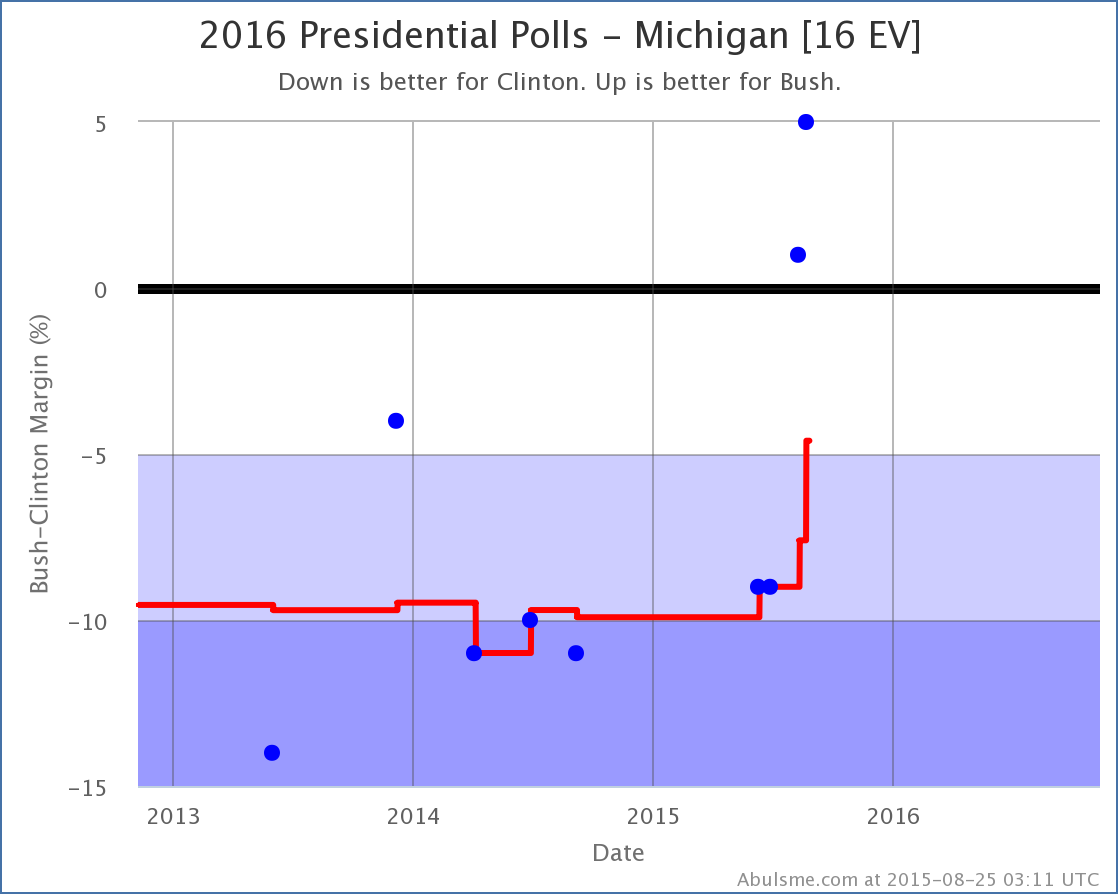
This pattern, a hockey stick type movement away from Clinton and toward various Republicans, has now shown up on the charts for quite a few different states, across a wide variety of Republicans. One or two of these in isolation look like outliers, but together they look like a real movement. Over the last few months Clinton has been weakening, and weakening quickly and dramatically.
So far, none of the Republicans are leading overall, but the best cases from Rubio and Bush both now include winning, and with Michigan now on the potential list for Bush as well, he improves his best case further:
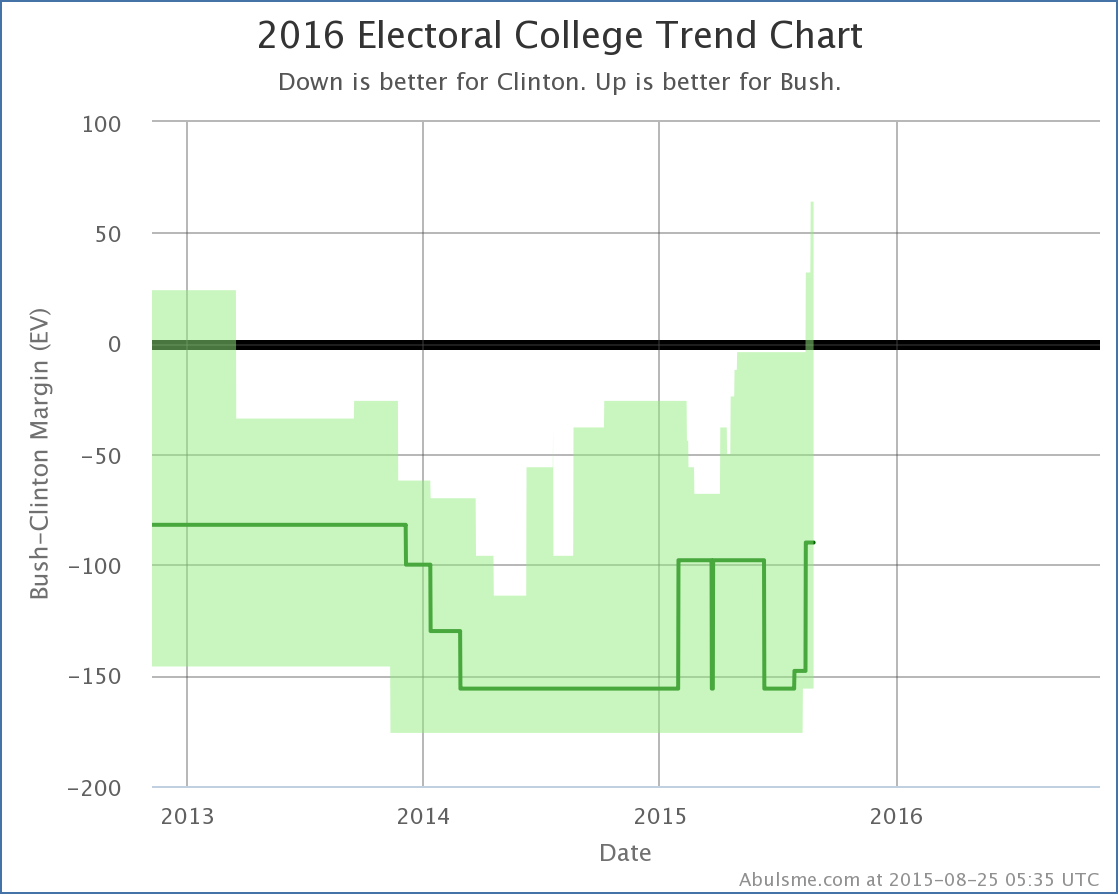
Bush’s best case, where he wins all of the states where he leads, plus all the states where Clinton is ahead by less than 5%, now is Clinton 237, Bush 301, a 64 electoral vote win for Bush. The expected case is still a 90 electoral vote loss for Bush, but he’s only a handful of close states away from a win. If the drumbeat against Clinton continues, do not be surprised if some of those states start to flip.
Clinton can’t be happy here. She is now below 50% in the Real Clear Politics national view of the Democratic nomination race, and her position in the general election has been slipping fast against the major Republican contenders. No wonder we’re getting all the Biden buzz, and people keep looking at Sanders. Right now she is showing weakness. The question is if she hits a floor, or keeps falling. And if she does keep falling, who takes advantage of it?
441.7 days until the polls start closing.
Note: This post is an update based on the data on ElectionGraphs.com. All of the charts and graphs seen here are from that site. Graphs, charts and raw data can be found there for the race nationally and in each state for every candidate combination that has been polled at the state level. In addition, comparisons of the best polled candidate combinations both nationally and each in each state are available. All charts above are clickable to go to the current version of the detail page the chart is from, which may contain more up to date information than the snapshots on this page, which were current as of the time of this post. Follow @ElecCollPolls on Twitter for specific poll details as I add them.
A bunch of changes today prompted by the latest Quinnipiac Swing State Poll. The TL;DR is that Clinton’s situation continues to deteriorate.
The Republicans are gaining on her, despite any talk myself or others have been doing about the Trump phenomenon hurting Republicans more generically. If that is going to happen, there is no good evidence of it yet, at least in state level general election polling.
Specifically, Rubio and Bush are nipping at Clinton’s heels. In today’s update, Bush’s best case moves into winning territory, Rubio’s already winning best case gets even better, both candidates improve their “expected” results and the tipping points are getting very close.
To actually win at this point, Rubio only needs to hold the states he already leads and flip North Carolina (Clinton +0.4%) and Pennsylvania (Clinton +2.4%). Bush has to flip a few states that are already leaning Rubio as well, but at this point he has his tipping point down to only a 3.8% Clinton lead. Easily within the reach of a campaign that goes his way.
Now the details for those who want them.
Clinton vs Rubio
Rubio moves states into better categories for him in Florida, Pennsylvania and Ohio. A quick look at all three charts:
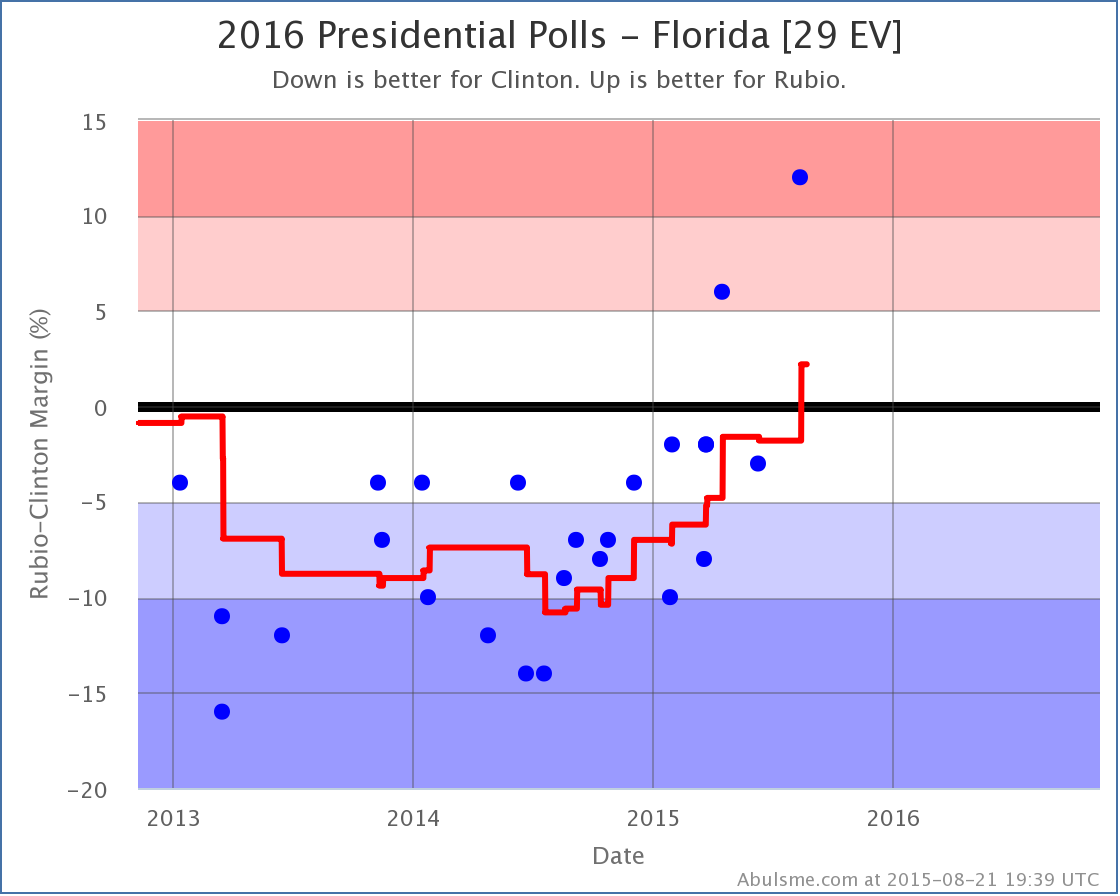
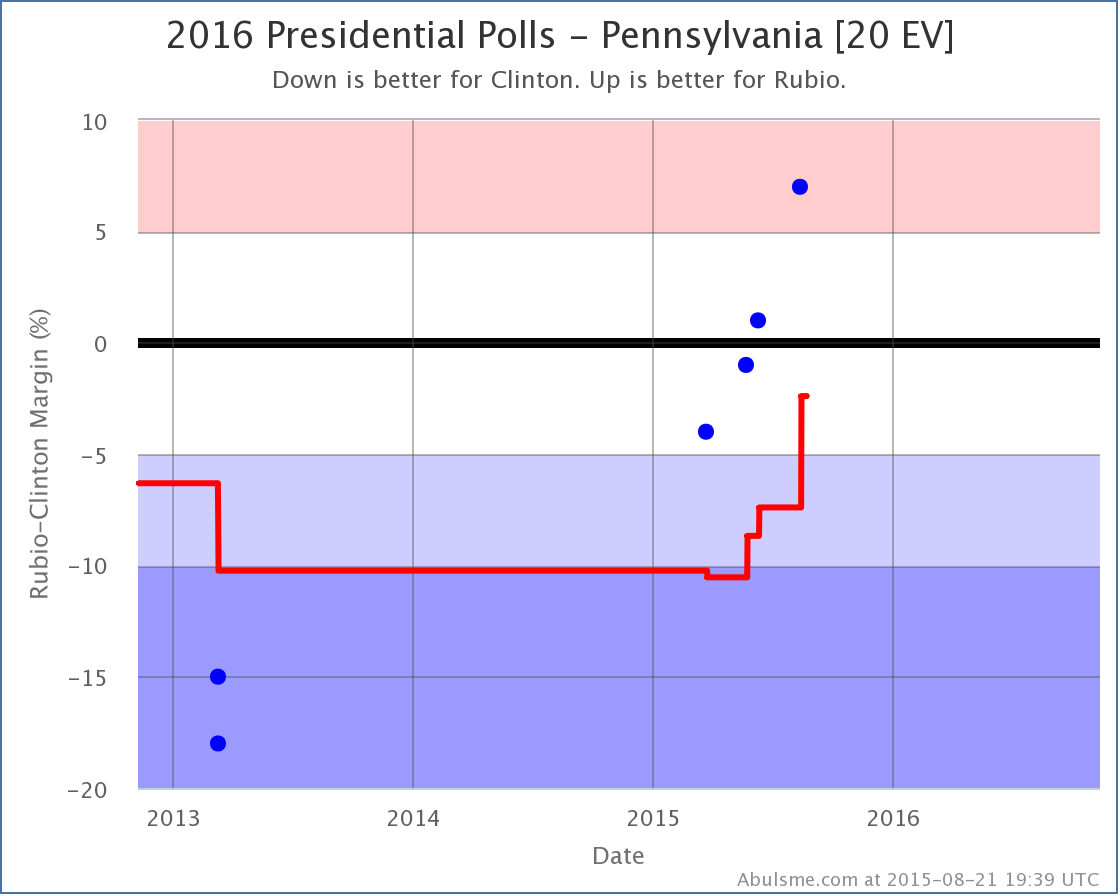
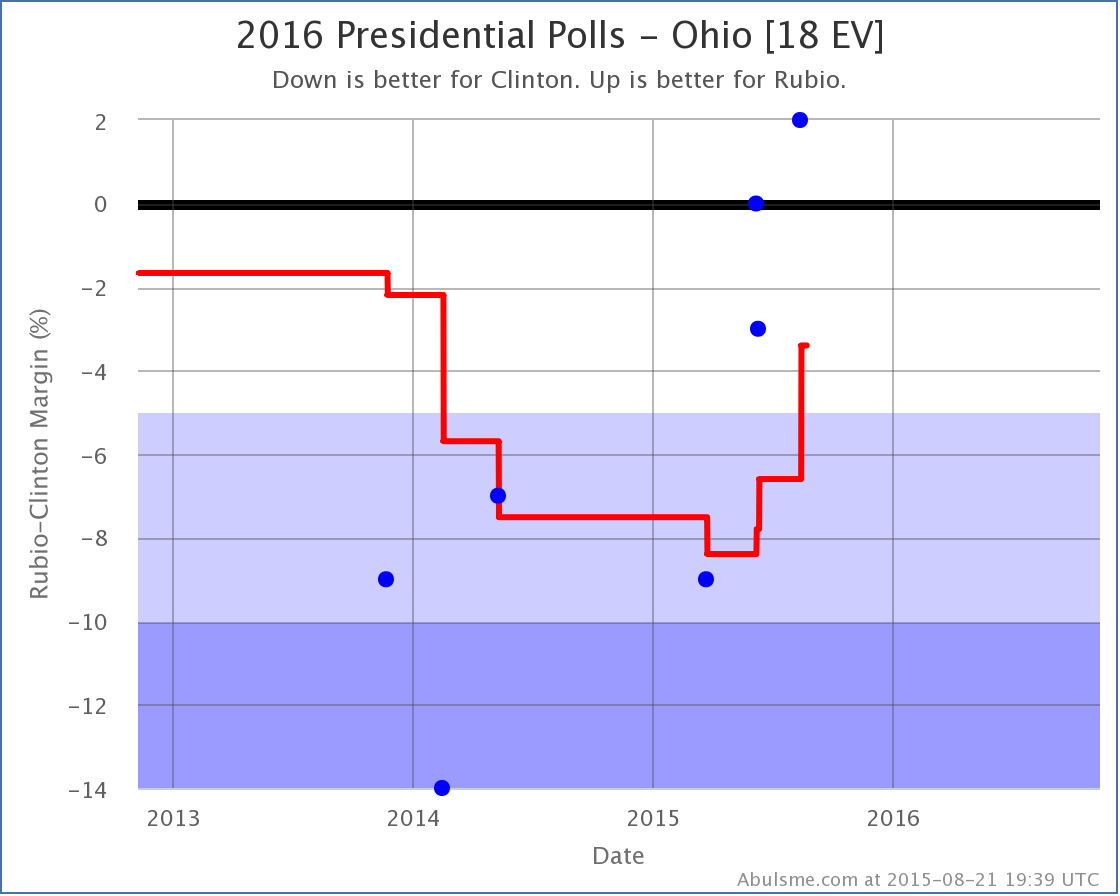
Now, an argument could be made that some of these new data points look like outliers. But we don’t know until we have follow up polls, and that is why we use poll averages and not single polls anyway, so we include the polls in the average and just see what that does.
Florida (29 ev) flips from Weak Clinton to Weak Rubio, improving Rubio’s expected result to Clinton 299 to Rubio 239. This is still a 60 point electoral point loss, but this is the best “expected case” we have seen on any Republican with a significant amount of state level polling against Clinton.
Meanwhile, with both Pennsylvania (20 ev) and Ohio (18 ev) moving from Strong Clinton to Weak Clinton, a very large chunk of electoral votes gets added into the “possible pick up” category for Rubio’s best case, which is now Clinton 227, Rubio 311… an 84 electoral vote WIN for Rubio. This is also the best “best case” we have seen for any significantly polled Republican so far.
This is what Rubio’s “bubble” looks like now:
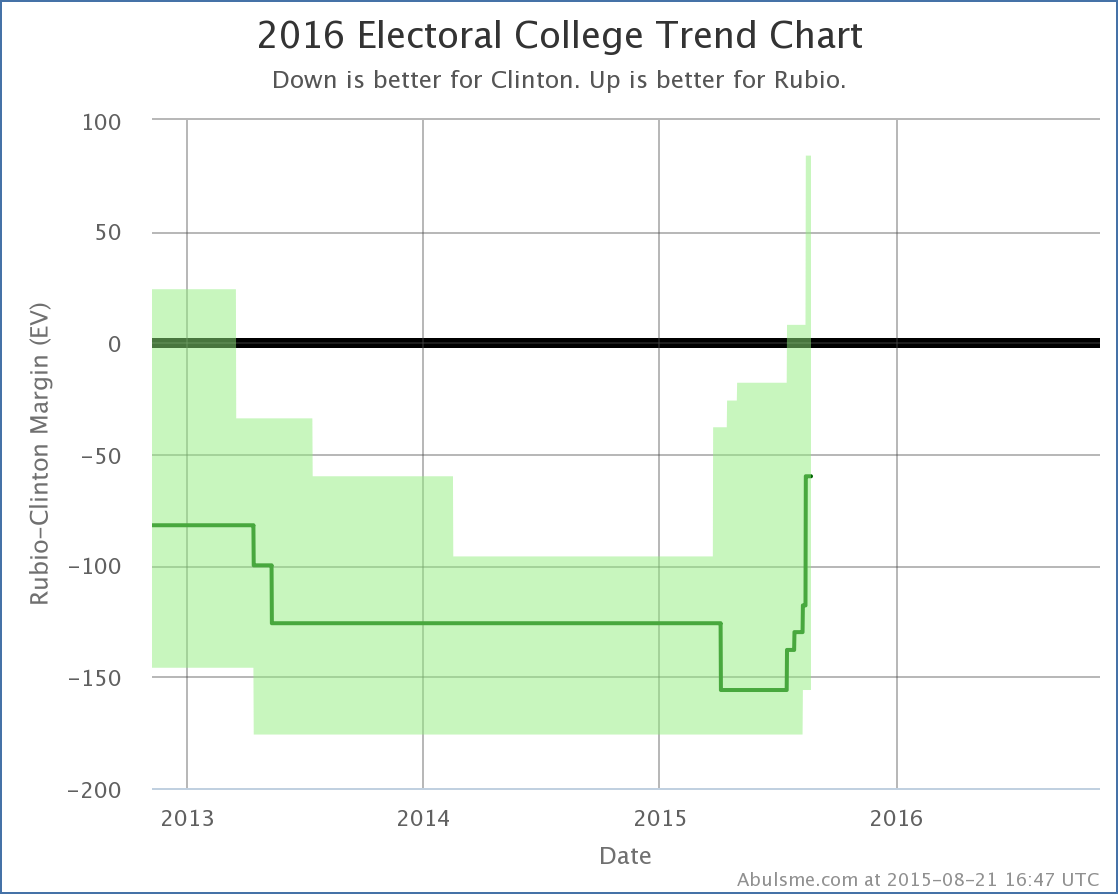
Florida, Pennsylvania and Ohio are huge electoral prizes. They make a massive difference on these charts. With a Republican in the lead in Florida, and competitive in Pennsylvania and Ohio, it really is a whole different ball game.
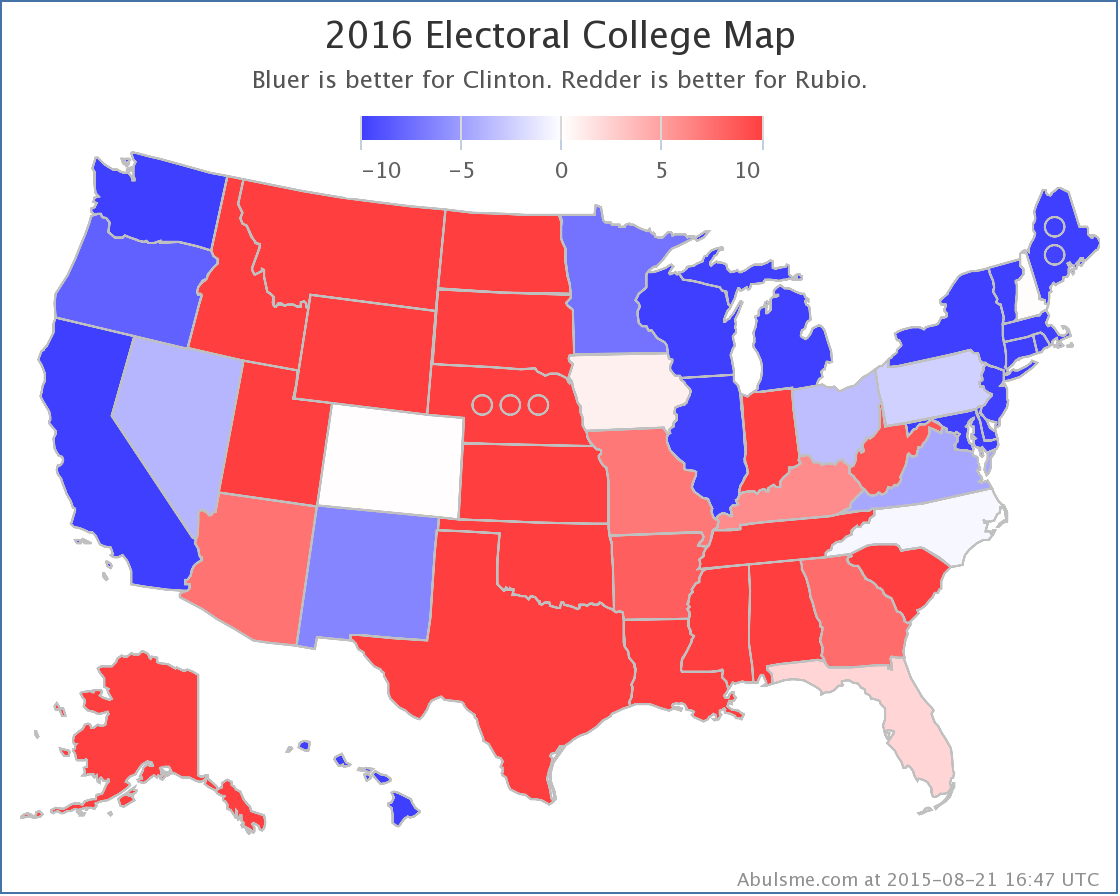
This is the Clinton vs Rubio map right now. With a map like this, Clinton still wins, but it is very very close, and the slightest issue would give the election to Rubio.
Clinton vs Bush
Looking at the Bush charts in FL/PA/OH:
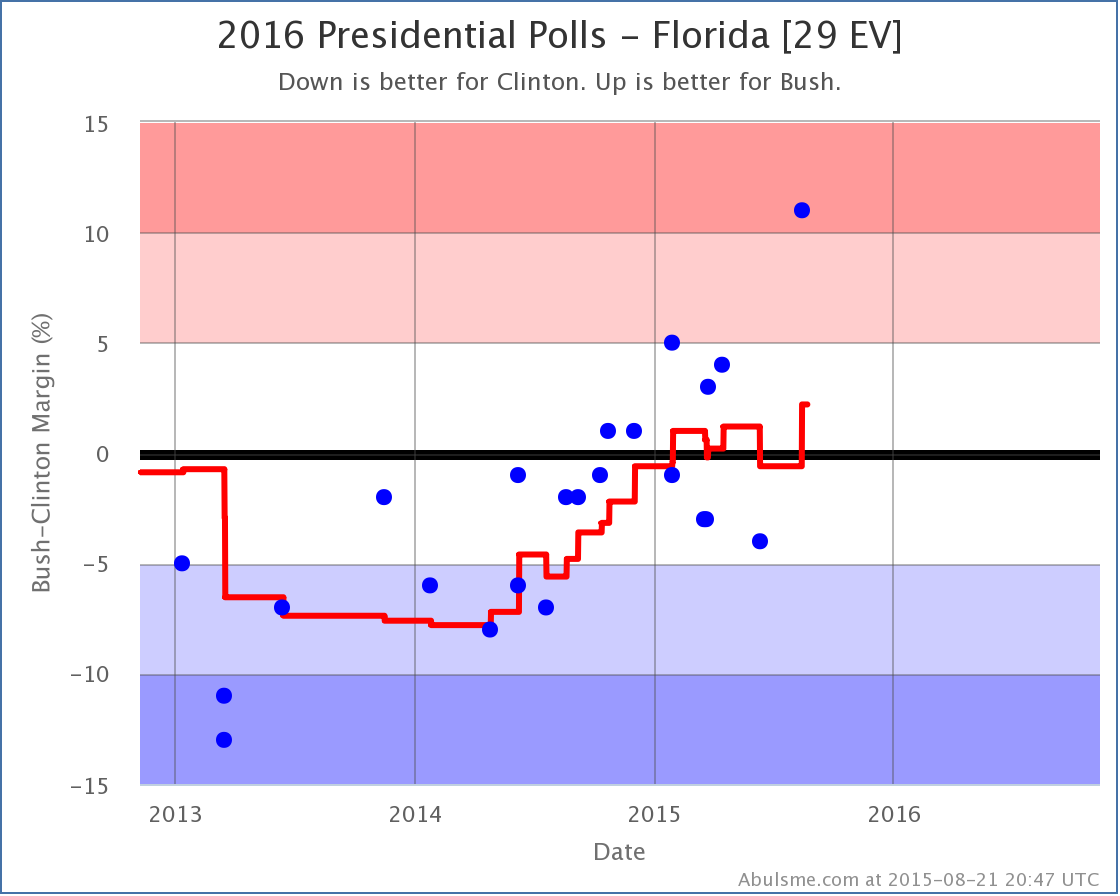
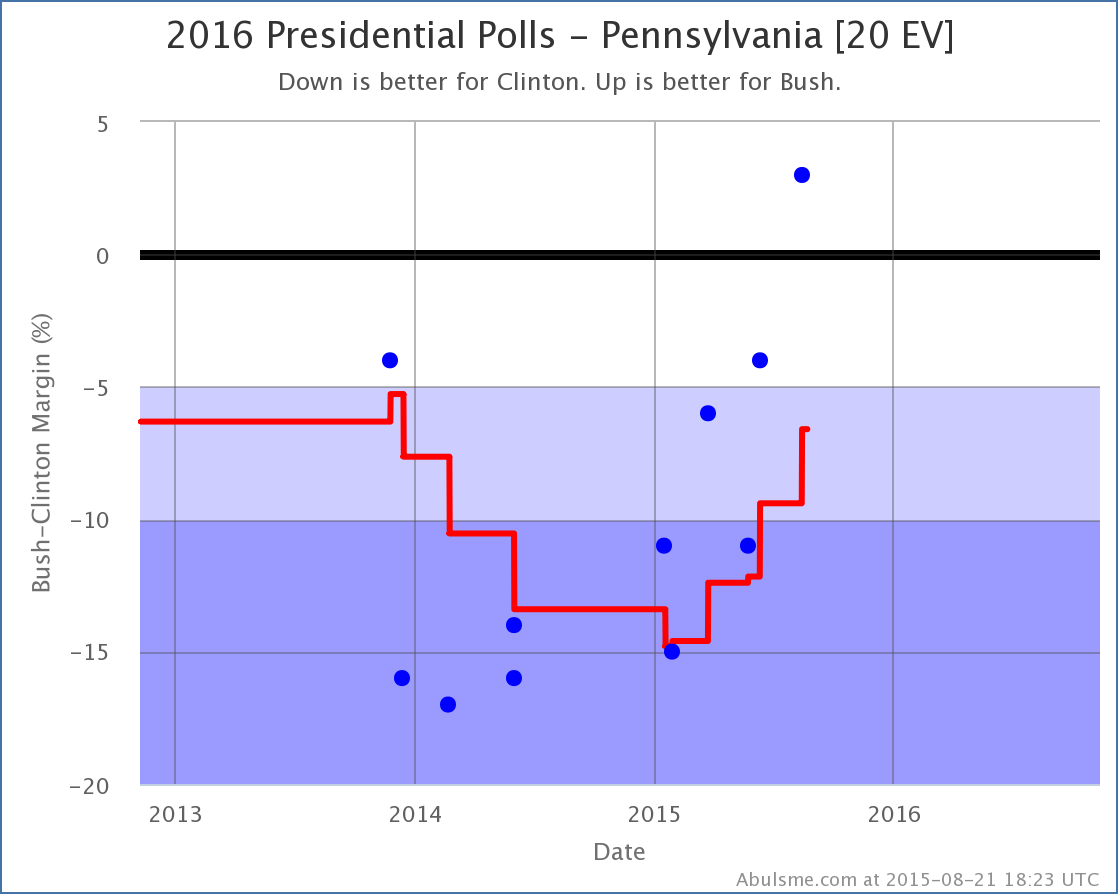
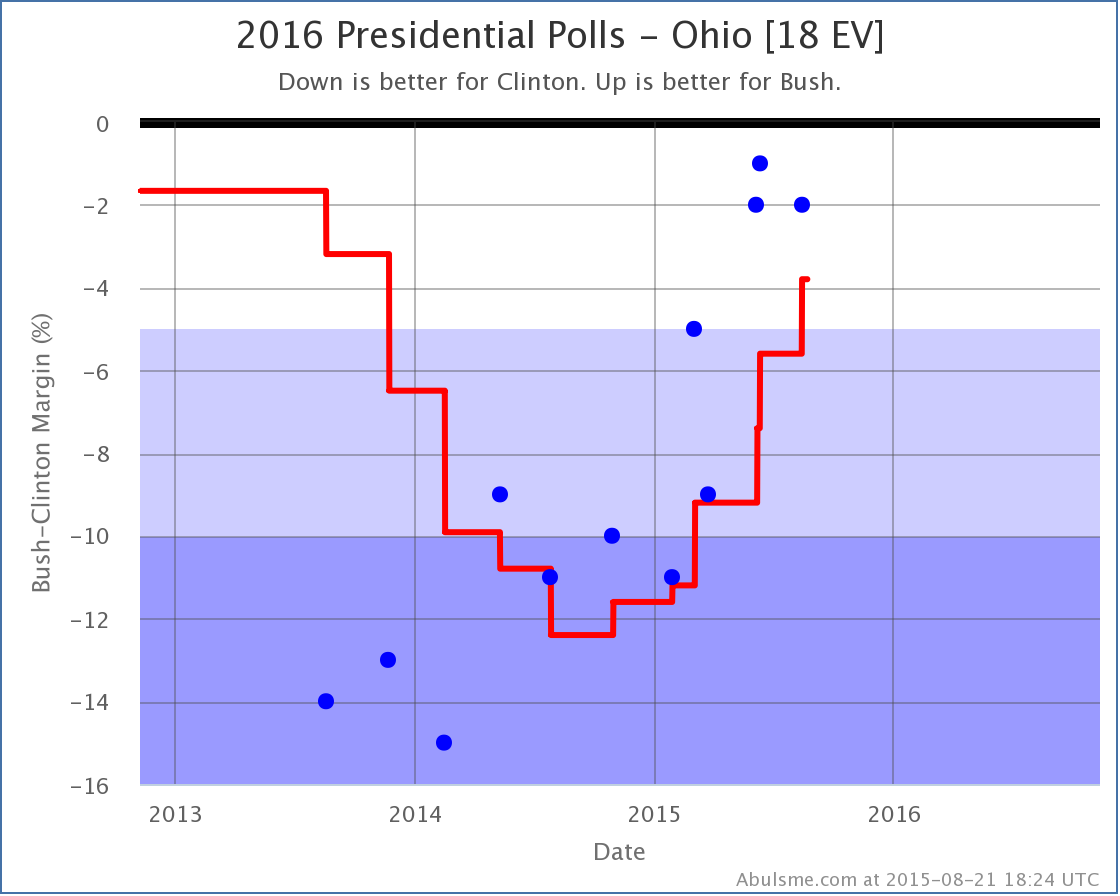
Bush also flips Florida. This improves Bush’s expected case to Clinton 314, Bush 224. This is a 90 electoral vote loss, but better than Bush has looked since late 2013.
And Bush also moves Ohio from Strong Clinton to Weak Clinton. Unlike Rubio though, he does not quite bring Pennsylvania into this category. The trend is there. Pennsylvania has been moving toward Bush all year. But Clinton’s lead is still over 5%. Perhaps that will change with the next poll. But Ohio by itself is enough to improve Bush’s best case to Clinton 253, Bush 285, which is a 32 electoral vote Bush WIN.
So we get Bush’s new bubble:
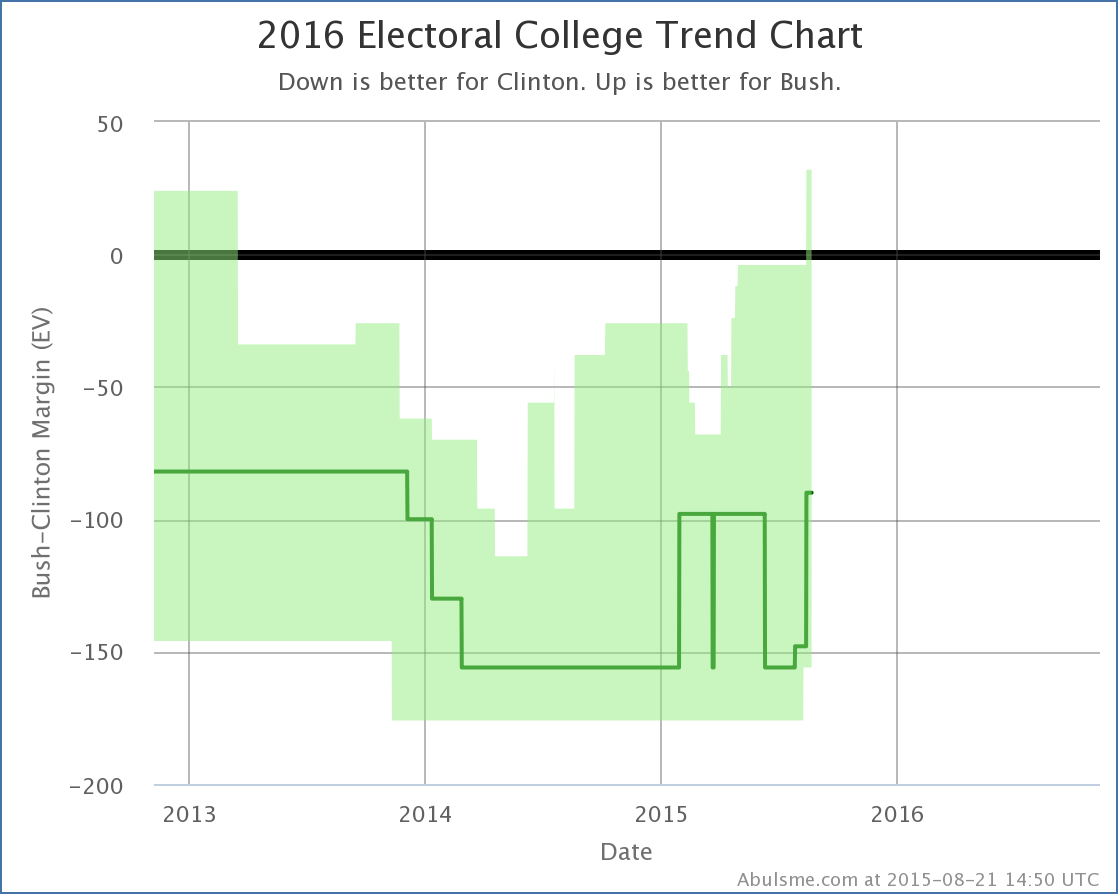
And his new map:
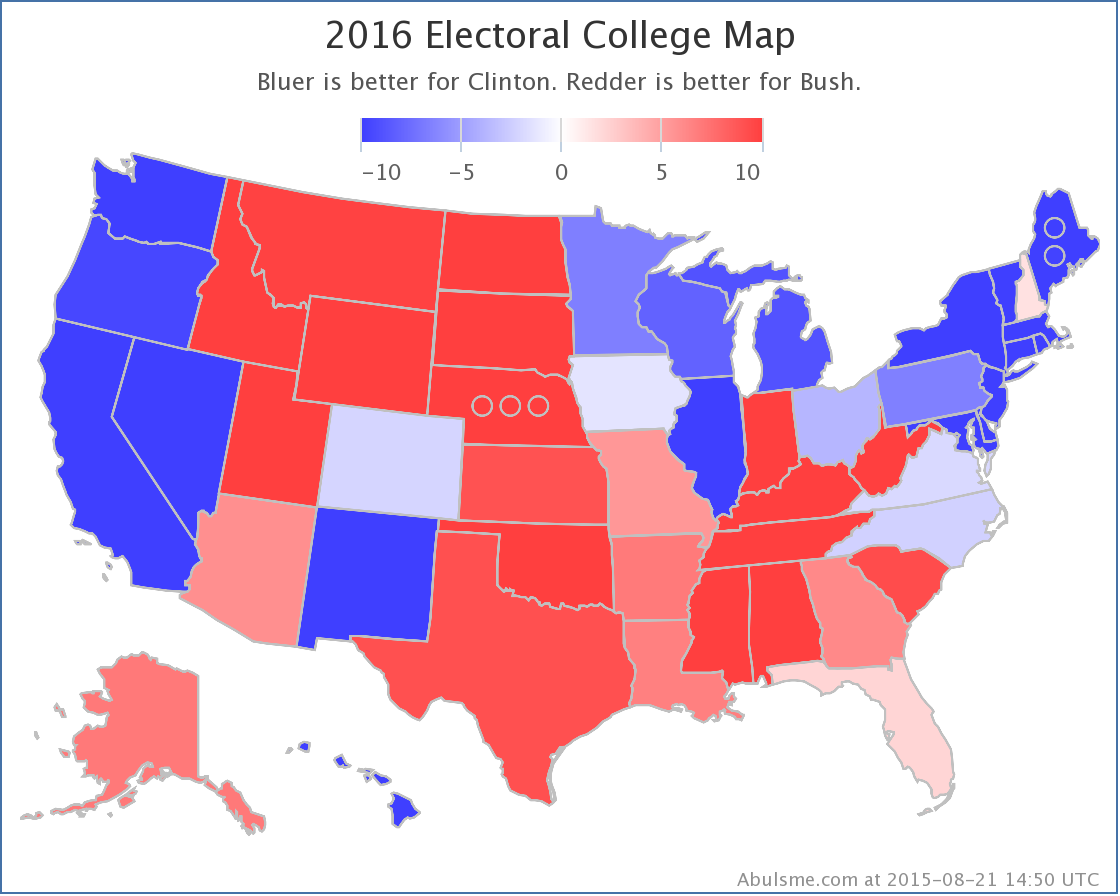
At this point, Clinton vs Bush and Clinton vs Rubio are the only two of the five best polled candidate pairs where the Republicans have a winning best case. But are the trends heading there for anybody else? Lets take a quick look.
Comparisons
Sometimes the national charts can give good comparative insight, but this time since we’ve been concentrating on FL/PA/OH, lets just look at those comparisons for now.
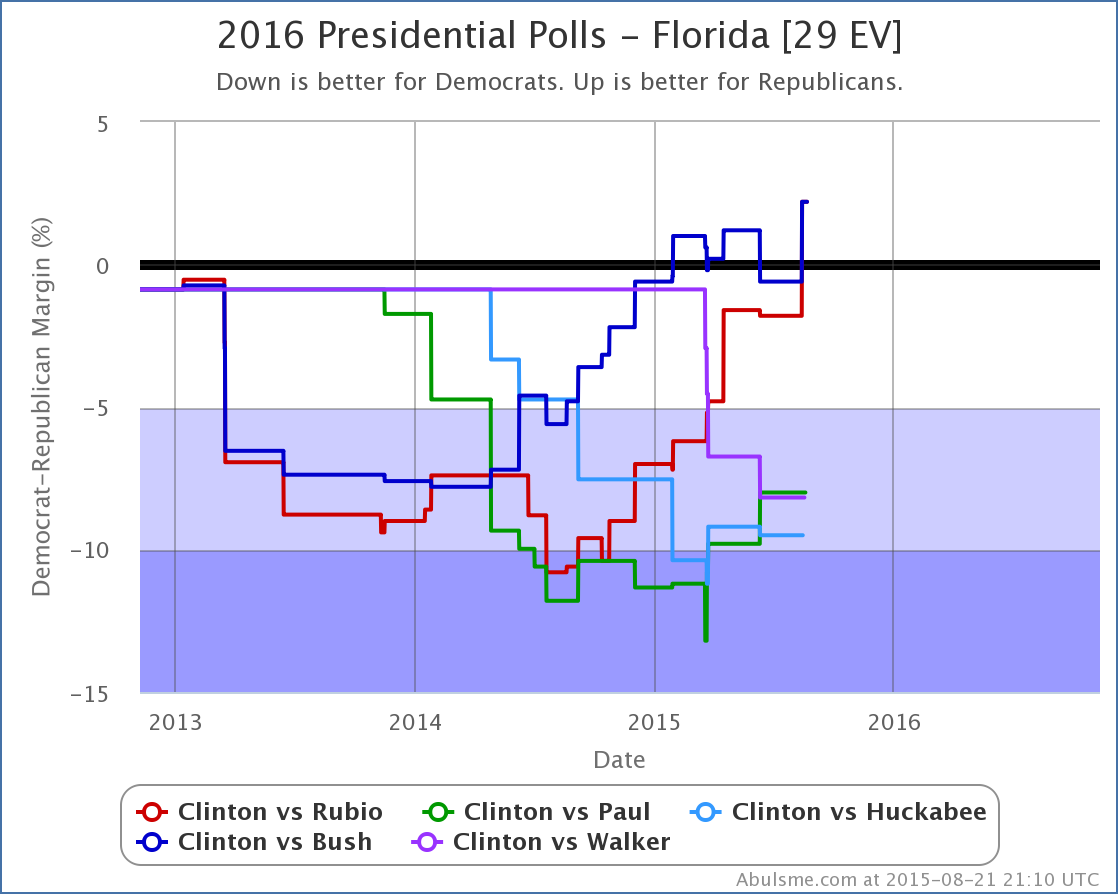
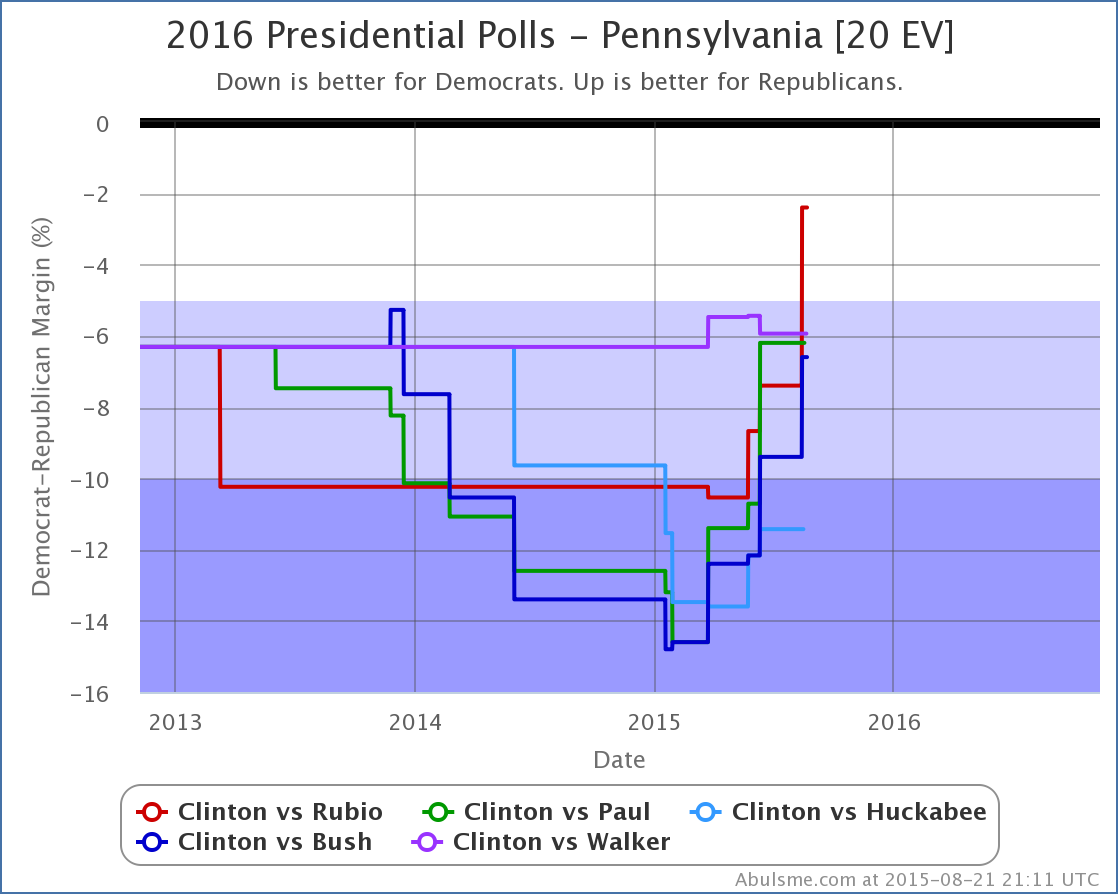
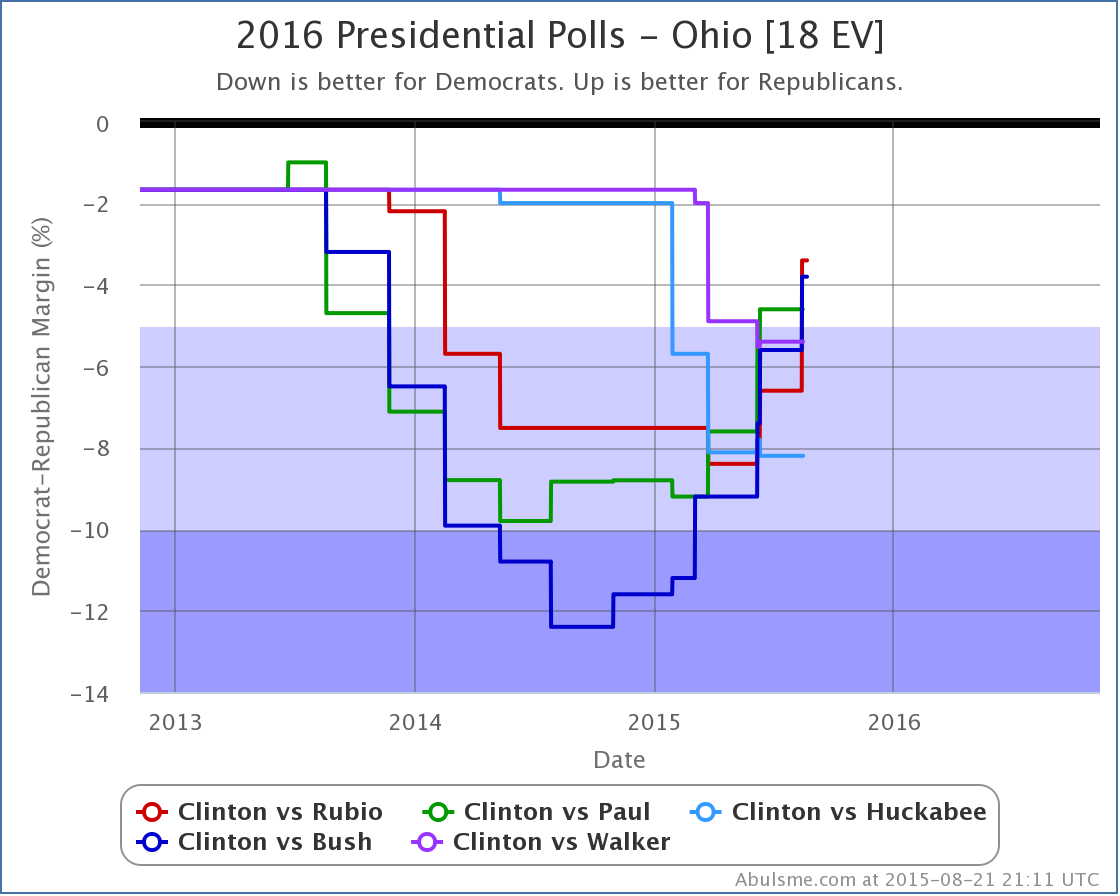
So just at a glance, in Ohio and Pennsylvania all or most Republicans are improving against Clinton. They almost seem to be moving as a bunch. (Except maybe Huckabee.)
But it looks different in Florida. In Florida, Rubio and Bush have separated themselves from the rest of the crowd. They are the only two of these five making Florida competitive. The others are just wandering around in Strong Clinton territory, with no clear trend between them.
It is very hard to map a Republican win without Florida. Possible maybe, but very hard. The trends are clearly going toward the Republicans in many states. For Rubio and Bush, Florida is doing the same. If the general trend against Clinton continues, we should start seeing other candidates gain ground in Florida too, but it isn’t in evidence yet.
But overall, Clinton is losing ground, and the race is getting closer.
445.1 days until polls start to close.
Note: This post is an update based on the data on my 2016 Electoral College Analysis Site. All of the charts and graphs seen here are from that site. Graphs, charts and raw data can be found there for the race nationally and in each state for every candidate combination that has been polled at the state level. In addition, comparisons of the best polled candidate combinations both nationally and each in each state are available. All charts above are clickable to go to the current version of the detail page the chart is from, which may contain more up to date information than the snapshots on this page, which were current as of the time of this post. Follow @ElecCollPolls on Twitter for specific poll details as I add them.
Two sets of changes worth noting today triggered by new PPP polls in Iowa and Missouri. The streak of changes going against Clinton and in favor of the various Republicans continues. As I mentioned before, the last time one of my updates was unequivocally good news for Clinton was in May!
Iowa

The July Qunnipiac Poll showing Rubio with an 8% is looking kind of like an outlier, and without it we wouldn’t be quite there yet, but there has been a clear trend toward Rubio in the average going back a year. With the newest poll (plus that possible outlier) the average moves from “Weak Clinton” to “Weak Rubio”. This changes the “expected” result in this matchup:
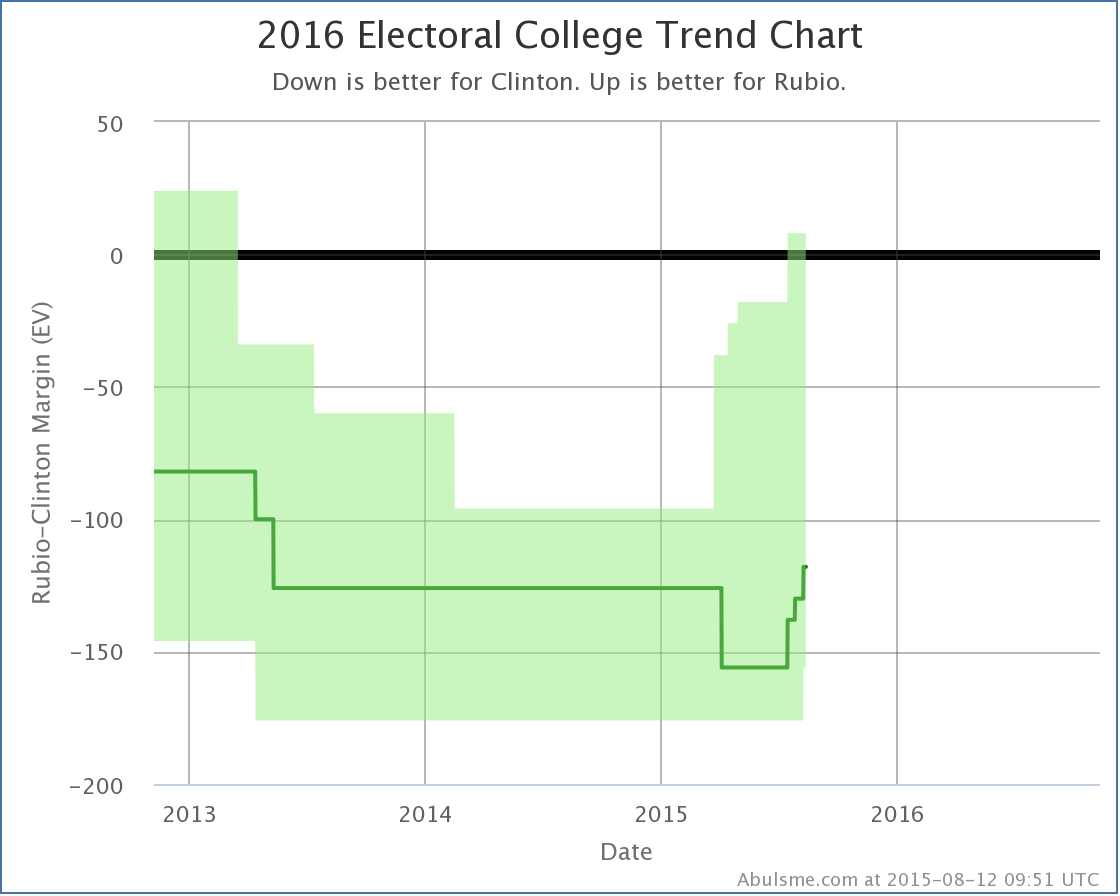
The expected result is now Clinton 328 to Rubio 210, which is a 118 electoral point loss by Rubio. Now, while this is still of course a significant loss, it is significant because it beats Romney’s 126 electoral vote loss against Obama in 2012. The last time one of the five best polled candidate combinations had the Republican outperforming Romney was back in June when Bush had pulled his expected loss down to only 98 electoral votes.
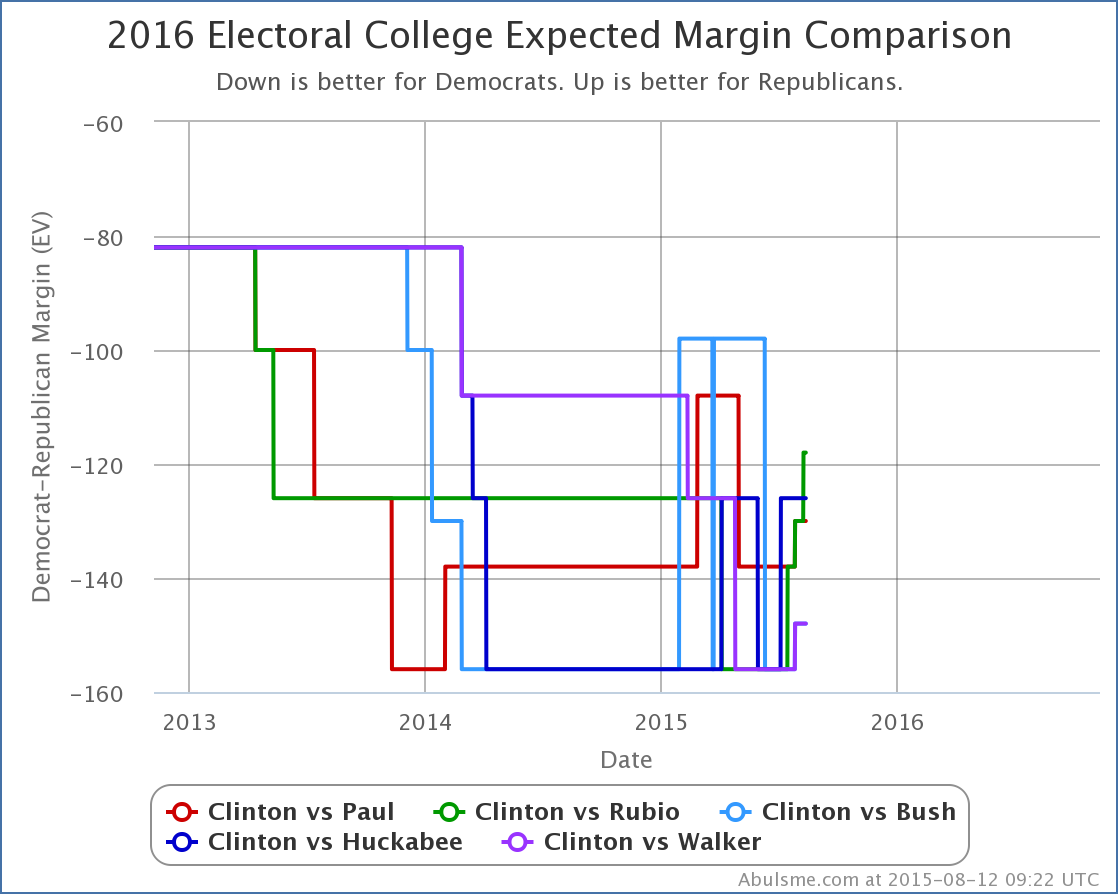
While there has been a general drumbeat of bad news for Clinton in my updates for the last three months, this particular chart doesn’t yet show an clear and indisputable breakout move beyond the range where these candidates have been bouncing around. If you only look at the changes since June, it starts to look like a trend though, and given the movement in other metrics, it is still reasonable to interpret this as a bad trend for Clinton.
The question though will be if the Republicans can start an actual breakout move where instead of talking about how it looks like they might beat Romney, we start talking about how it looks like they might beat Clinton. We aren’t close to that yet.
One thing people have been speculating about has been if the prominence of Trump on the Republican side right now is actually harming the party overall, specifically in terms of the ability of the other candidates to compete against Clinton. So far, there is no evidence for that at all in the numbers we track here.
Missouri
When I officially launched the election tracking site and posted my first analysis for 2016 I mentioned that if you looked at the average results for the last five general elections… the data I used to “seed” the analysis before there were actual state polls… there were only SIX states where the average margin in these five elections was less than 5%. They were Nevada (Dem+2.8%), Ohio (Dem+1.7%), Florida (Dem+0.9%), Colorado (Rep+0.0%), Virginia (Rep+1.6%) and Missouri (Rep+2.8%). All of these states were polled long ago, some many times… except Missouri. Today’s PPP poll is the first 2016 polling for Missouri that I am aware of. So finally, we get a current view of the state.
Missouri was basically on this “Close State” list because Bill Clinton won the state by 6.3% in 1996, the oldest of the five elections I used for the initial average. Since then the Republicans won by 3.3%, 7.2%, 0.1%, and 9.4%. OK, that 0.1% in 2008 was really close. And the 3.3% in 2000 wasn’t a complete blow out. But in general it seems like the trend has been redder in Missouri.
The new poll tested Clinton against 11 different Republicans. She lost by between 7% and 15% depending on which Republican you looked at. (They also tested Sanders against 4 Republicans with similar results.)
Bottom line, looks like 2016 is looking a lot more like 2012 or 2004 than 2008 or 2000. That is, a pretty strongly Republican state. Now, it is just one poll, but the results are strong enough that the state immediately moved from “Weak Republican” to “Strong Republican” for all five of the best polled candidate combinations. (And actually for all the rest of the combinations they polled too.)
The chart of this isn’t actually all that interesting on a state level. But Missouri no longer being a close state means that Clinton’s “best case” against all five Republicans weakens a little bit, so lets have a quick look at that graph:
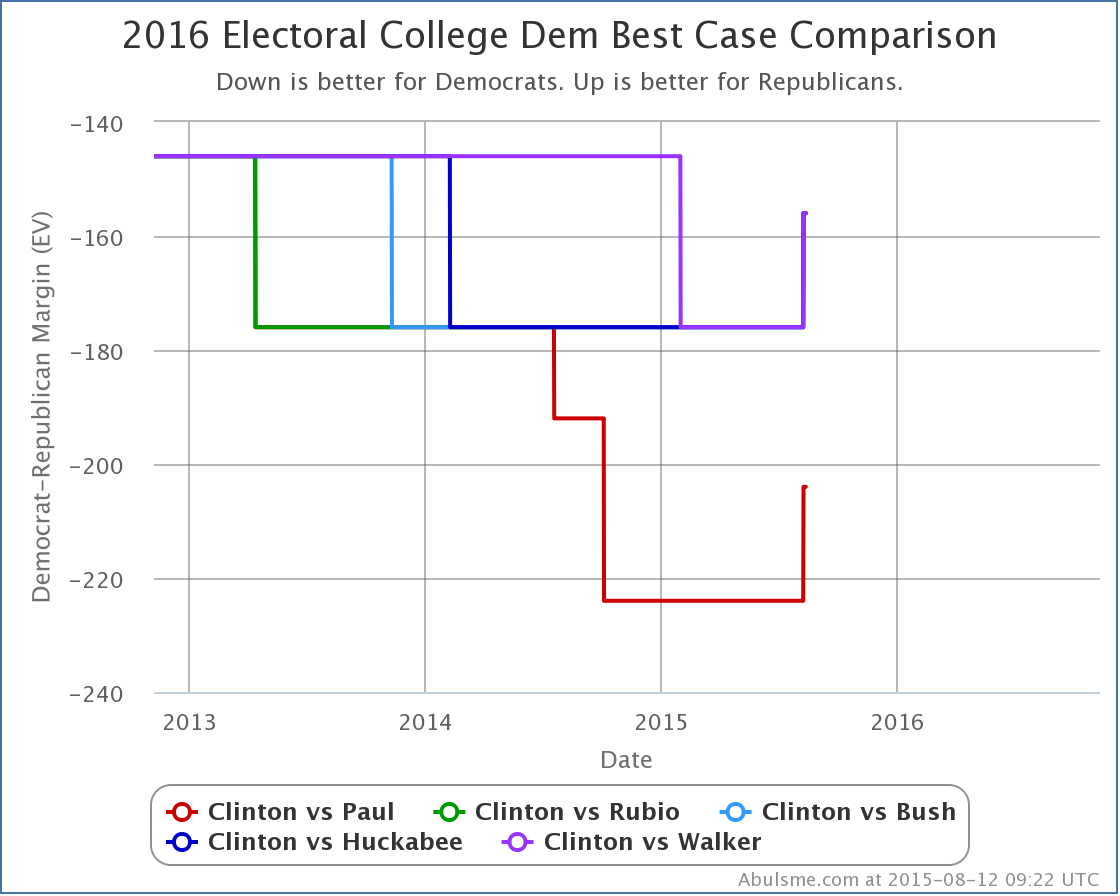
You don’t see a lot of volatility in this chart, simply because there are a lot fewer polls of the states that make a difference here. You see a lot of polls around the tipping point, and around the states that are really close, because they give insight into if the Republicans are catching up. Given the current state of Clinton’s lead, polling of the states Republicans are generally already ahead in only gives insight into how much extra Clinton could win by if everything possible went her way, which is fundamentally less interesting.
Never the less, with Missouri’s 10 electoral votes out of play at the moment, Clinton’s best case margin drops by 20 electoral votes against all these candidates. In the case where she wins all the states she is ahead in, plus all the states where the Republican currently leads by less than 5%, she now beats Paul by 204 electoral votes. Rubio, Bush, Huckabee and Walker get beaten by a more modest 156 electoral votes. These are of course pretty good margins in today’s polarized electorate. But to get to these kinds of numbers, just about everything would have to go Clinton’s way… which is not the trend today.
But of course, we have 454.2 days until the election. Lots can change in 454.2 days. :-)
Best Polled List
I should also mention that the “best polled” list got shuffled a bit with the latest updates. Clinton vs Paul once again grabs the “best polled” spot and becomes the default view on election2016.abulsme.com. Meanwhile Clinton vs Christie drops to 6th place and out of the group we highlight here, replaced by Clinton vs Huckabee returning to the top five after a short absence. Clinton vs Huckabee is just barely out of the top 5, but any other candidate combinations are far behind in terms of the volume and breadth of available polling on the state level at the moment. We’re currently giving the most attention here to Clinton vs Paul, Rubio, Bush, Huckabee and Walker.
Note: This post is an update based on the data on my 2016 Electoral College Analysis Site. All of the charts and graphs seen here are from that site. Graphs, charts and raw data can be found there for the race nationally and in each state for every candidate combination that has been polled at the state level. In addition, comparisons of the best polled candidate combinations both nationally and each in each state are available. All charts above are clickable to go to the current version of the detail page the chart is from, which may contain more up to date information than the snapshots on this page, which were current as of the time of this post. Follow @ElecCollPolls on Twitter for specific poll details as I add them.
First of all, a little bookkeeping. With the latest batch of polls, the “five best polled candidate combinations” gets shuffled up a bit. Clinton vs Huckabee falls off the top five (bye Huck!), replaced by Clinton vs Walker. Meanwhile, Clinton vs Rubio moves into the “best polled” slot, becoming the default view on the election2016.abulsme.com site. So, for the moment, that means the candidate combinations I’ll talk about in these updates are Clinton vs Rubio, Paul, Bush, Walker and Christie. Huckabee honestly is very close behind in the #6 spot. After that though there is a pretty big gap in polling before we get to the next combinations. There may be lots of talk about Trump lately. Or of Biden or Sanders as Clinton alternatives. Or of the other ELEVEN Republican candidates. But in comparison to the combinations I mentioned earlier, state level polling involving those folks is still pretty sparse. We’ll talk about the rest of the candidates if and when there is good enough polling on them to get them into the top five. Or at least close.
OK, with that out of the way, the main news from the latest polls. Specifically, with a WMUR poll in New Hampshire added in, this happened:
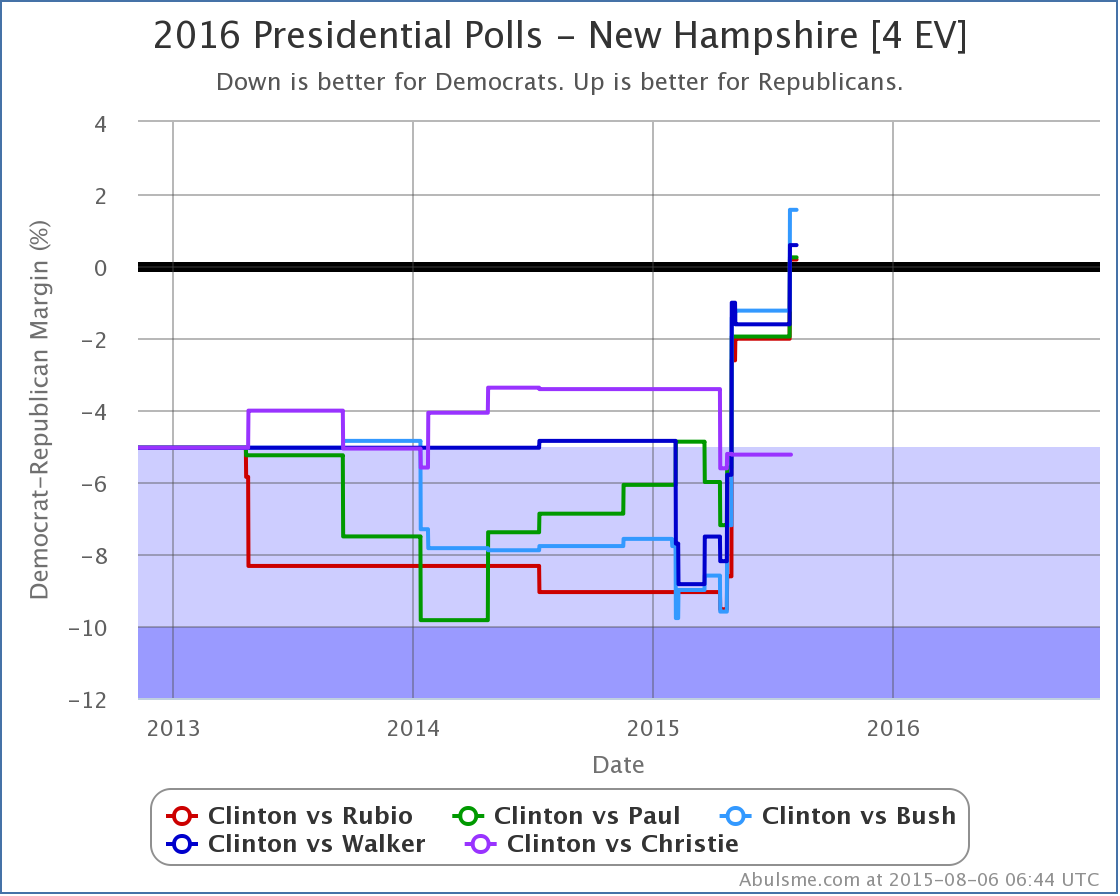
Rubio, Paul, Bush, and Walker all took the lead in New Hampshire as measured by my poll average. Just barely. But still. They are now in the lead. Christie wasn’t polled this time, but was lagging the others quite a bit anyway.
Just a few months ago, New Hampshire was looking like it was pretty reliably “Strong Clinton” against almost all Republican challengers. (The exception being Christie amusingly enough, since he is now the weakest of the bunch.) This is a pretty big move. It seems to be parallel across many candidates, so it is likely this is more a case of Clinton getting weaker than anything any Republican candidate is doing specifically.
So what does New Hampshire flipping do to the “expected” results if the election was held today?
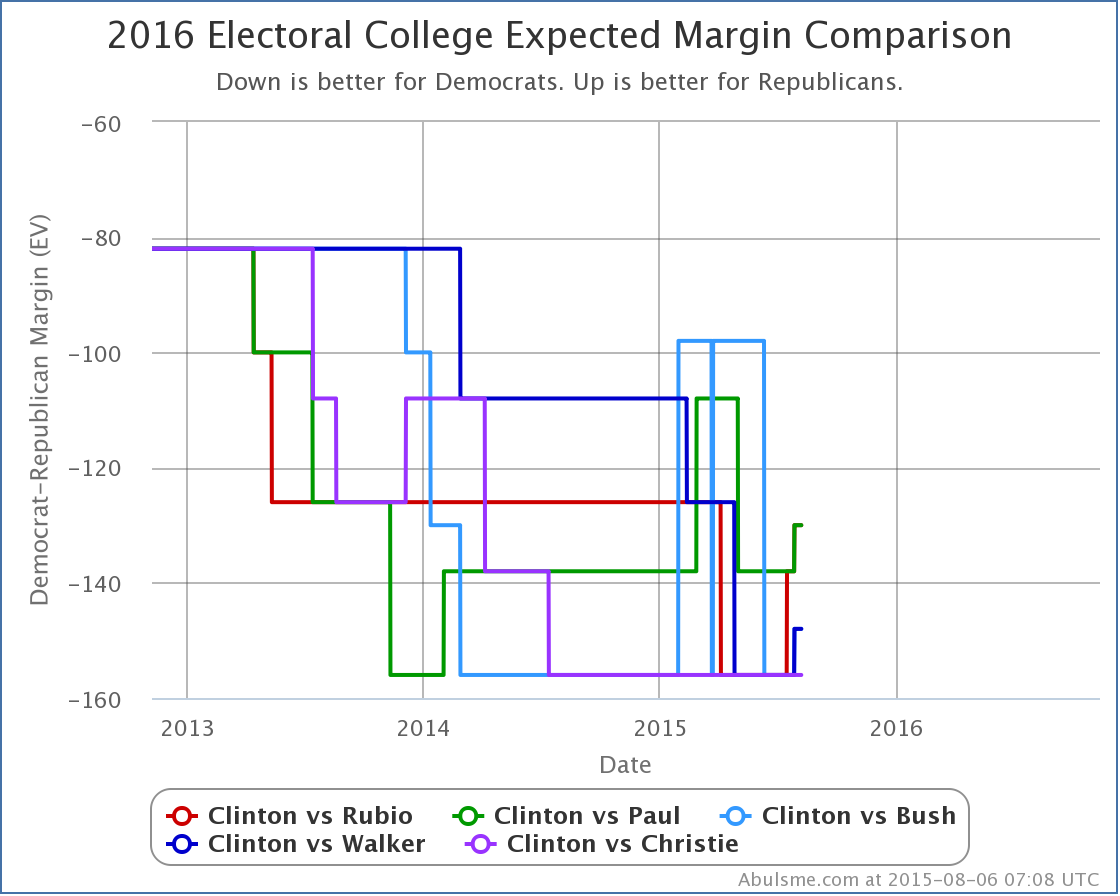
Well, OK, a couple bumps there at the end. Even with this though, this particular chart doesn’t show a clear trend. All the lines are bouncing around, but aren’t clearly trending in one direction or another.
But, looking more generally at my Electoral College updates, the last time I did one that was fully and unreservedly about something moving in Clinton’s direction was in May! From the end of May, through June, through July, and now into August, every update has been about Republican gains. (There were a couple Clinton gains in the mix, but there were always overshadowed by moves toward the Republicans that happened at the same time.)
Despite this, everything points to Clinton still being way ahead overall. As one example of this, even with New Hampshire, none of the five candidates on the chart above even match Romney’s performance in 2012. The best of the bunch in “expected result”, Rubio and Paul, still lose to Clinton by 130 electoral votes.
Clinton can’t be happy with the trend though. Yes, things are expected to tighten. But I’m sure she would prefer if they didn’t anyway!
We still have lots of time until the election. The first Republican debates are coming up later today. Obviously the main thing people will be watching for are how it may impact the standing of the various candidates in the Republican race, but Democrats and Independents are watching too, so don’t be surprised if there are effects on the general election matchup too.
And of course, this is just the beginning of debate season. Many more to come…
460.7 days until the first general election polls close.
Note: This post is an update based on the data on my 2016 Electoral College Analysis Site. All of the charts and graphs seen here are from that site. Graphs, charts and raw data can be found there for the race nationally and in each state for every candidate combination that has been polled at the state level. In addition, comparisons of the best polled candidate combinations both nationally and each in each state are available. All charts above are clickable to go to the current version of the detail page the chart is from, which may contain more up to date information than the snapshots on this page, which were current as of the time of this post. Follow @ElecCollPolls on Twitter for specific poll details as I add them.
To get the headline out of the way… for the first time since officially launching my 2016 electoral college polling tracking back in November, one of the Republicans with a significant amount of state level polling is within reach of Clinton. We now see a scenario where “if the election was held today” and the Republican was to outperform their polling… but by an amount that is not inconceivable… then the Republican would win.
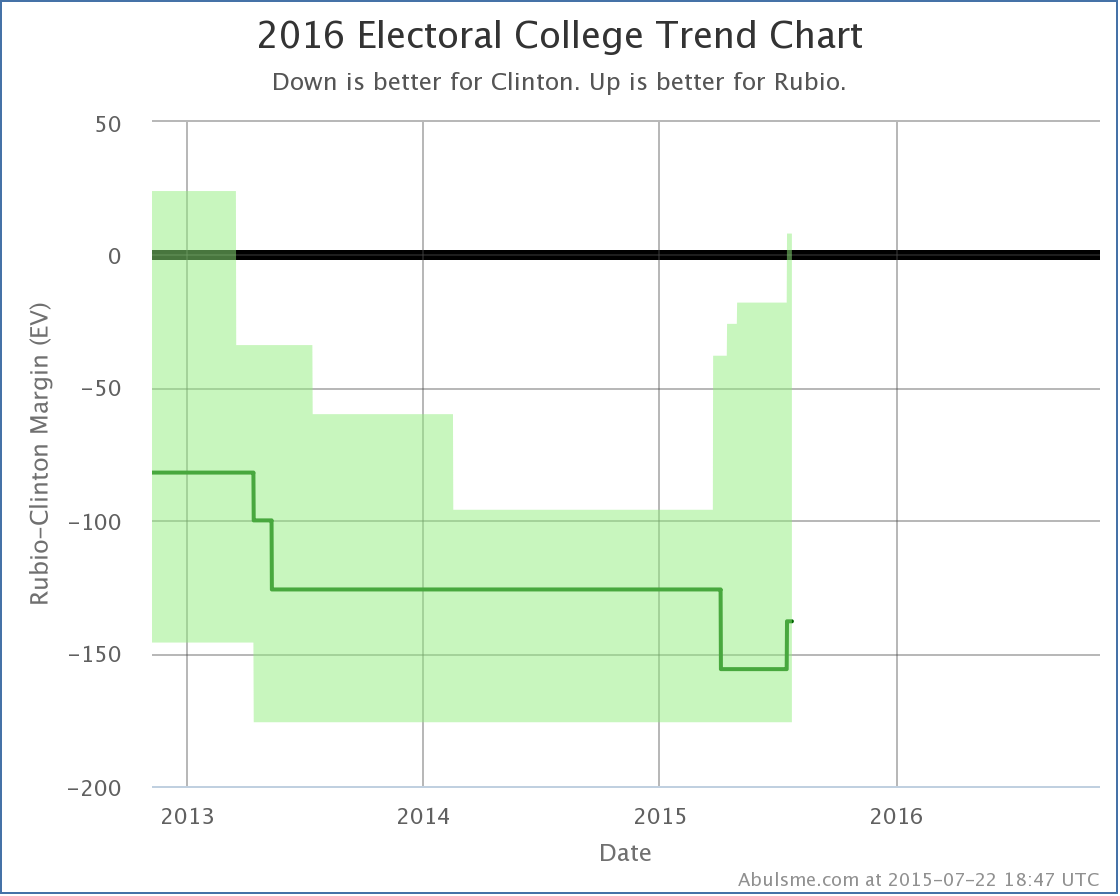
Specifically, while Clinton is still ahead against all five of the “best polled” Republicans challenging her (Bush, Rubio, Paul, Christie and Huckabee), if you give Rubio not only all the states he is already ahead in, but also all of the states where Clinton’s lead is less than 5%, then we end up with Clinton 265 to Rubio 273, a narrow 8 electoral vote victory for Rubio. The idea here is that a 5% lead is small enough that it can easily slip away under the right circumstances. So this does’t mean that Rubio is actually ahead, but it means that Rubio winning against Clinton is within the realm of the plausible.
This also shows up in the “tipping point”, which now shows a Clinton lead of less than 5% for the first time since our launch:
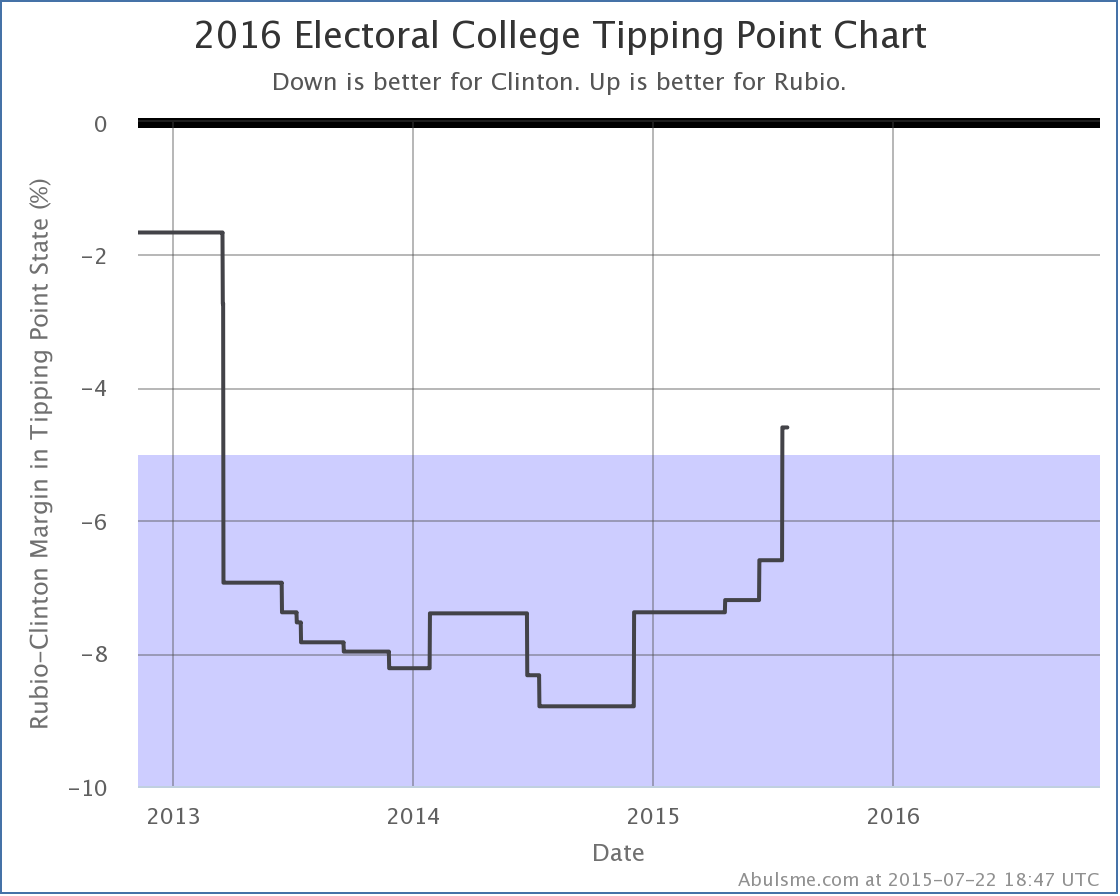
Rubio is the first Republican to manage this, but trends have been against Clinton in recent months. Bush is just barely short of this marker. His best case is to lose by only 4 electoral votes. If he makes one more state close, winning will also be within range. And Paul isn’t that much further behind.
Yes, yes, Clinton is still significantly ahead, the best any Republican does if you just give them the states they are actually ahead in is to match Romney’s loss in 2012. But still, we now have at least one Republican where the polls are close enough that a victory is at least imaginable! So as per the title we have a race!
Now the state level details for those who want them…
Qunnipiac released the latest results in their Presidential Swing State Poll series today. There was a lot of buzz about how bad it was for Clinton, showing her behind to Bush, Walker and Rubio in Colorado, Iowa and Virginia. Indeed, this single poll looked really bad for her in all three states… in fact enough out of line with other recent results that it is very tempting to think it may just be an outlier rather than a real indication of a major change.
Of course, that is why we do poll averages. Looking at the averages, adding these new results moves things toward the Republicans, but nowhere near as dramatically as if you just looked at the Quinnipiac results in isolation.
Quinnipiac polled nine different candidate combinations, but I only look at the five combinations that have the best polling over all. So I’m not going to talk about the Sanders vs Bush matchup that Quinnipiac polled. Sorry. (That’s the 17th best polled candidate combination by the way.)
Anyway, of the five best polled combinations, only Clinton vs Rubio had any significant changes. Beyond the headline, lets look at the two states that actually changed status.
First off, Colorado:
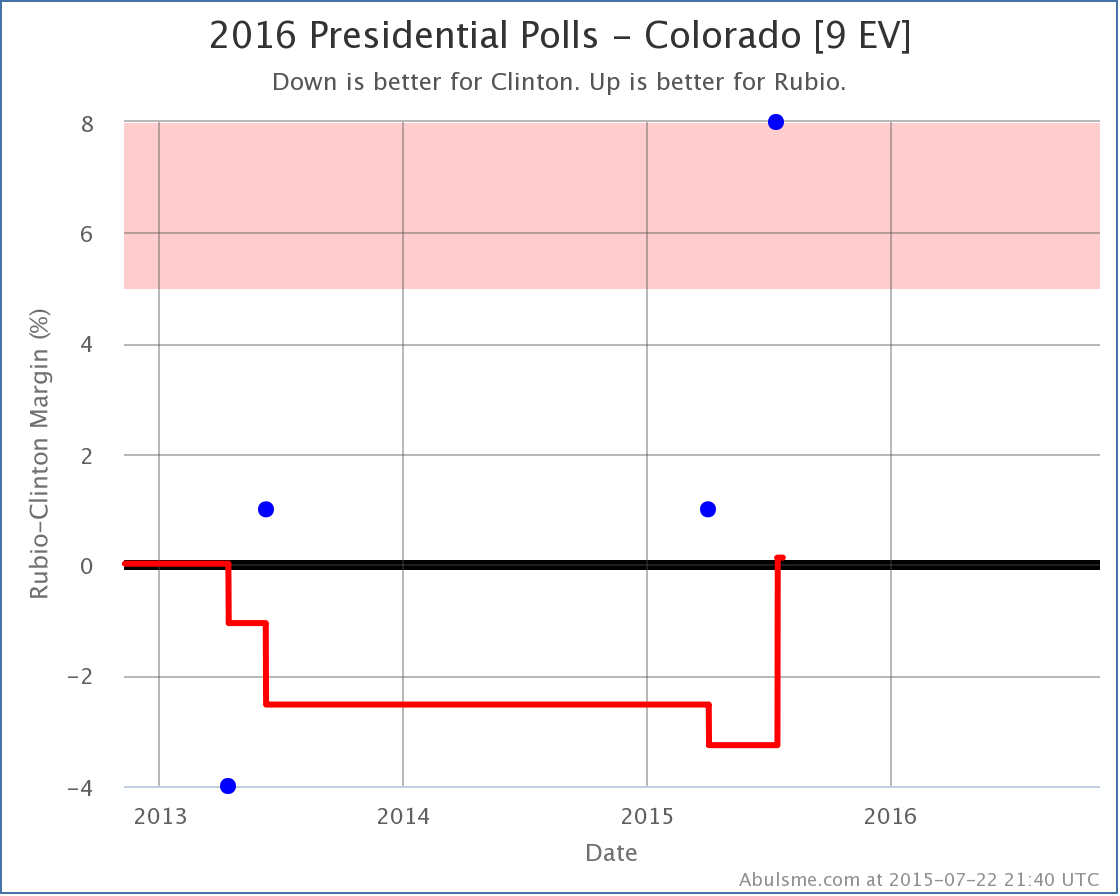 ‘ ‘
Clinton vs Rubio in Colorado has been very lightly polled… only four polls since the 2012 election, so the 2012 election results themselves are still included in the average. But the latest result is just enough to leave Rubio ahead by 0.1%. With Rubio now ahead in Colorado, the “expected” electoral college result moves to Clinton 338, Rubio 200, a 138 electoral vote margin for Clinton. (For comparison, Obama’s margin over Romney was 126 electoral votes.)
Virginia also changed categories:
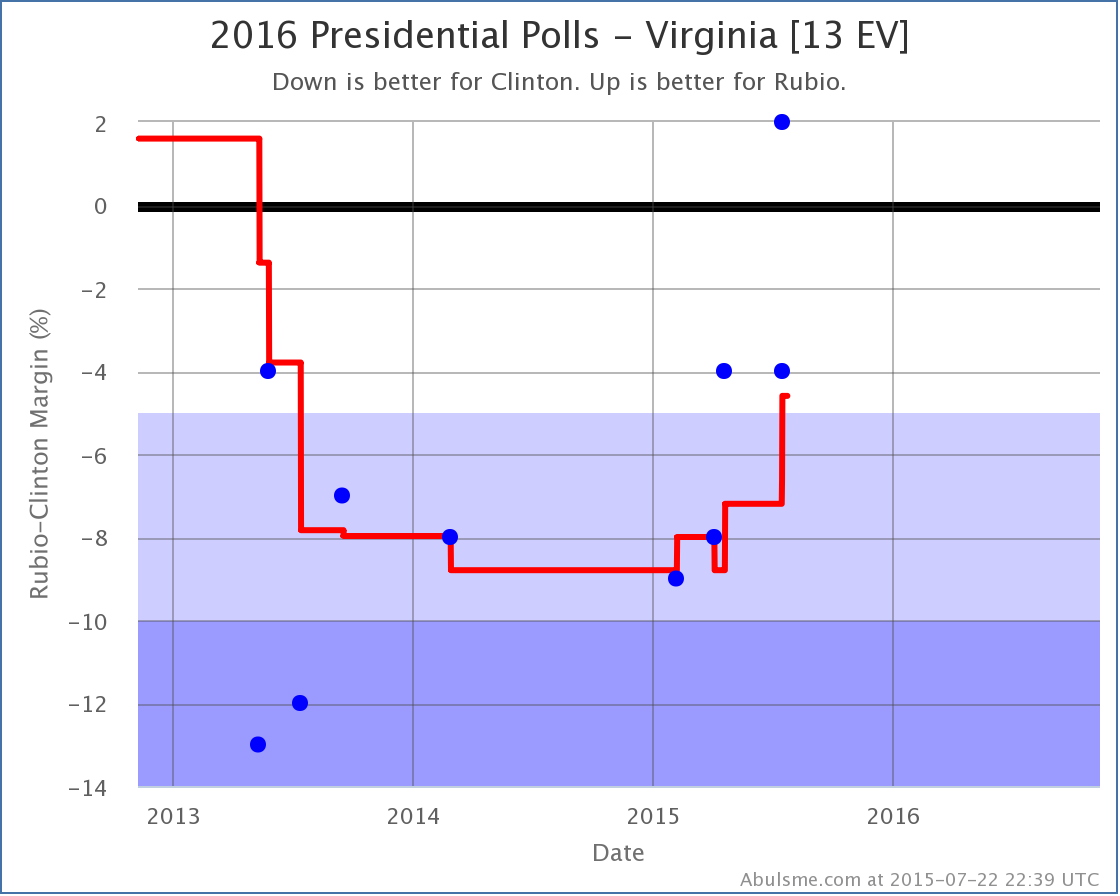
There have been quite a few more Clinton vs Rubio polls in Virginia than there were in Colorado. The new Quinnipiac poll accelerated a trend toward Rubio, and pushed Virginia from “Strong Clinton” to “Weak Clinton”. This is of course what prompted the improvement in Rubio’s best case and put him within reach of Clinton.
The full Clinton vs Rubio spectrum looks like this today:

And the full summary:
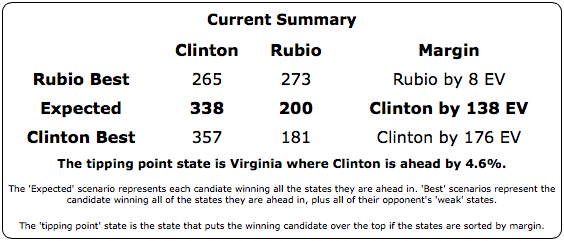
To win, Rubio would still need to flip North Carolina (1.2% Clinton lead), Iowa (1.3% Clinton lead), Florida (1.8% Clinton lead), New Hampshire (2.0% Clinton lead), Nevada (3.8% Clinton lead) and Virginia (4.6% Clinton lead). That sounds like a lot, but if national events or campaigning move things across all states, it means only 2.3% of voter have to change their minds to change the outcome. Even in today’s highly polarized climate, that is easily imaginable.
So, for the first time since the 2012 elections, it is starting to look like we have a real race. This is not unexpected. In my November post “The Race Begins” I said:
The real campaign against Clinton hasn’t ramped up yet. Lots of mud will be thrown. And the Republican candidates will get more and more visibility. Although anything is possible in either direction, it is quite possible that what we are seeing right now will be Clinton’s high water mark. The race is likely to get closer as we move through 2015 and people get more engaged.
Yup. That looks like what has been happening.
475.0 days until the first general election polls close.
Note: This post is an update based on the data on my 2016 Electoral College Analysis Site. All of the charts and graphs seen here are from that site. Graphs, charts and raw data can be found there for the race nationally and in each state for every candidate combination that has been polled at the state level. In addition, comparisons of the best polled candidate combinations both nationally and each in each state are available. All charts above are clickable to go to the current version of the detail page the chart is from, which may contain more up to date information than the snapshots on this page, which were current as of the time of this post. Follow @ElecCollPolls on Twitter for specific poll details as I add them.
Since my last electoral college post, there have been PPP polls in Virginia and Nevada. The only one of the top five “best polled” candidate combinations with a significant change is Clinton vs Paul, and it is good news for Paul.
Clinton vs Paul
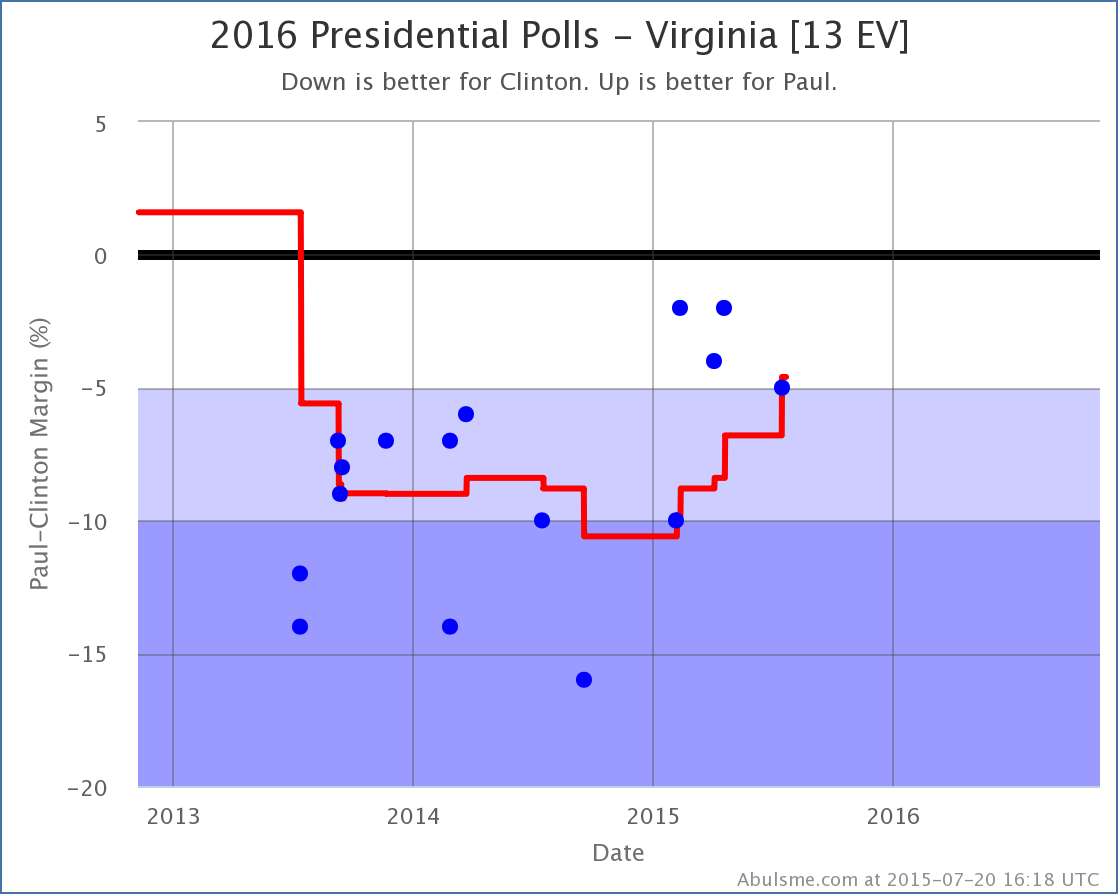
With this latest poll, my average of Clinton vs Paul in Virginia moves to Clinton by 4.6%. While still a substantial Clinton lead, it means Virginia moves to “Weak Clinton” in my average, and I now allow the possibility that Paul could win Virginia. This improves his “best case” where he wins all the states where he leads in the polls, plus all the states where Clinton is ahead by less than 5%.
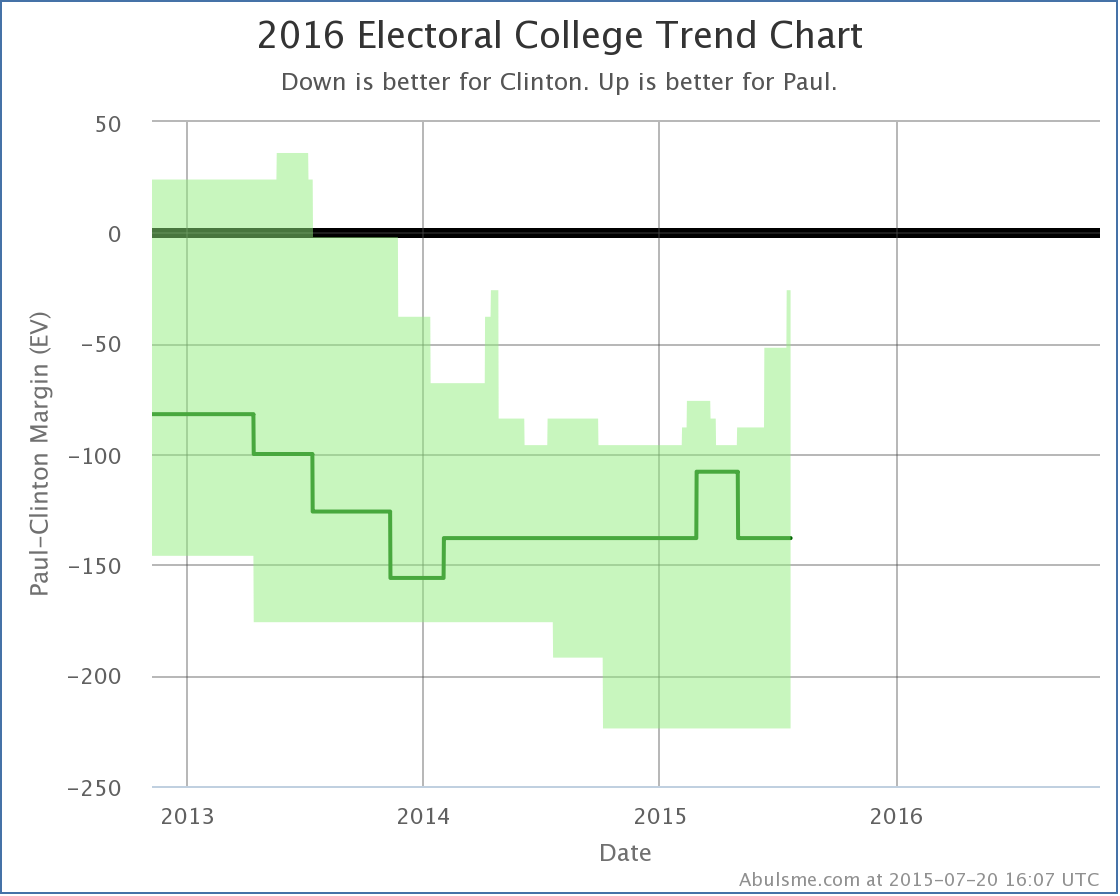
The spike on the upper right is this improvement. Paul’s best case here is still to lose by 26 electoral votes, but this is better than his best case has been since April 2014, and it has been on an upward trend since the beginning of May. So while he isn’t really moving the needle yet on actually bringing more states over to his side of the fence, he is making a few closer, which of course needs to happen first.
The change in Virginia also moved the “tipping point”… basically how far ahead the winning candidate is in the state that would “put them over the edge” in the electoral college. This is a measure of how much polls would have to move nationally, taking into account the structure of the electoral college, in order to flip the election to the other side.
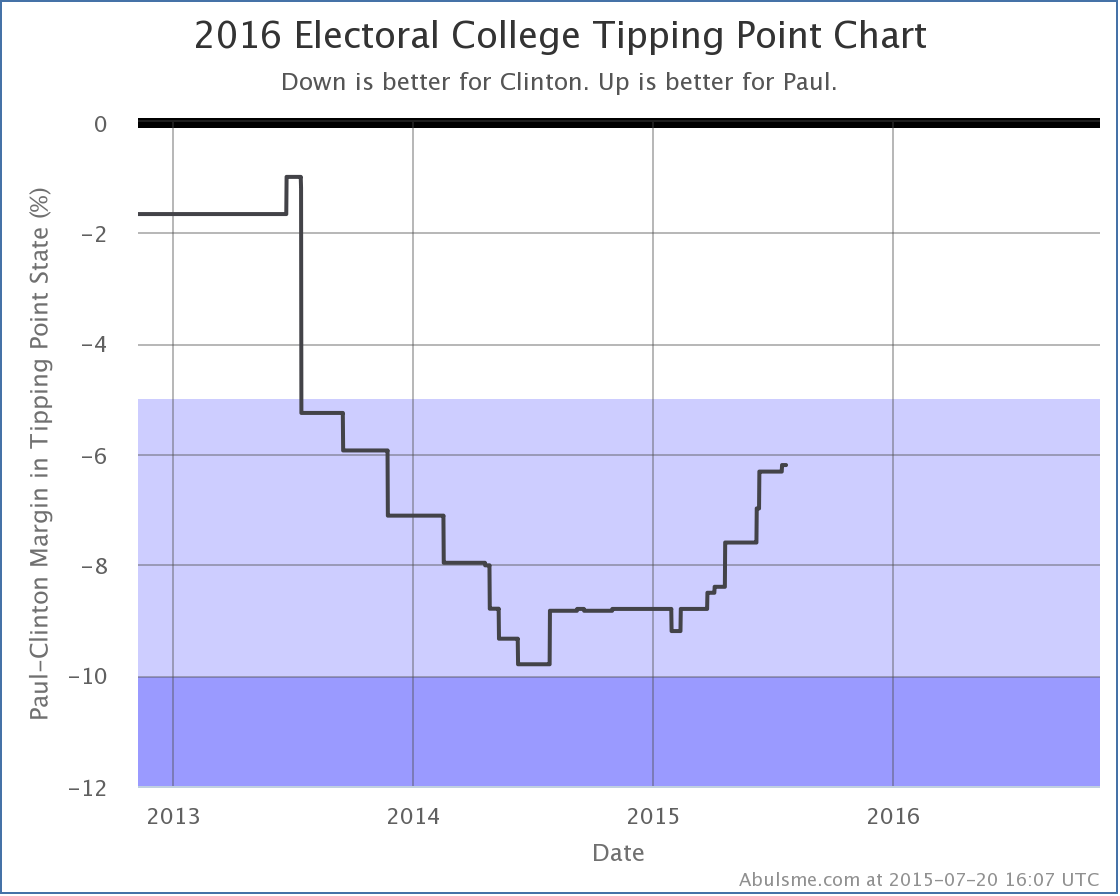
On this metric Paul has had nothing but moves in his direction since February. Slowly but surely his situation has been improving. It of course still has a long way to go. But the trend is there.
Everybody Else
So, we do have to ask the usual question. Is this really Paul getting stronger? Or is this just Clinton getting weaker? So lets look at the comparisons with all of the five best polled candidate combinations.
First Virginia:
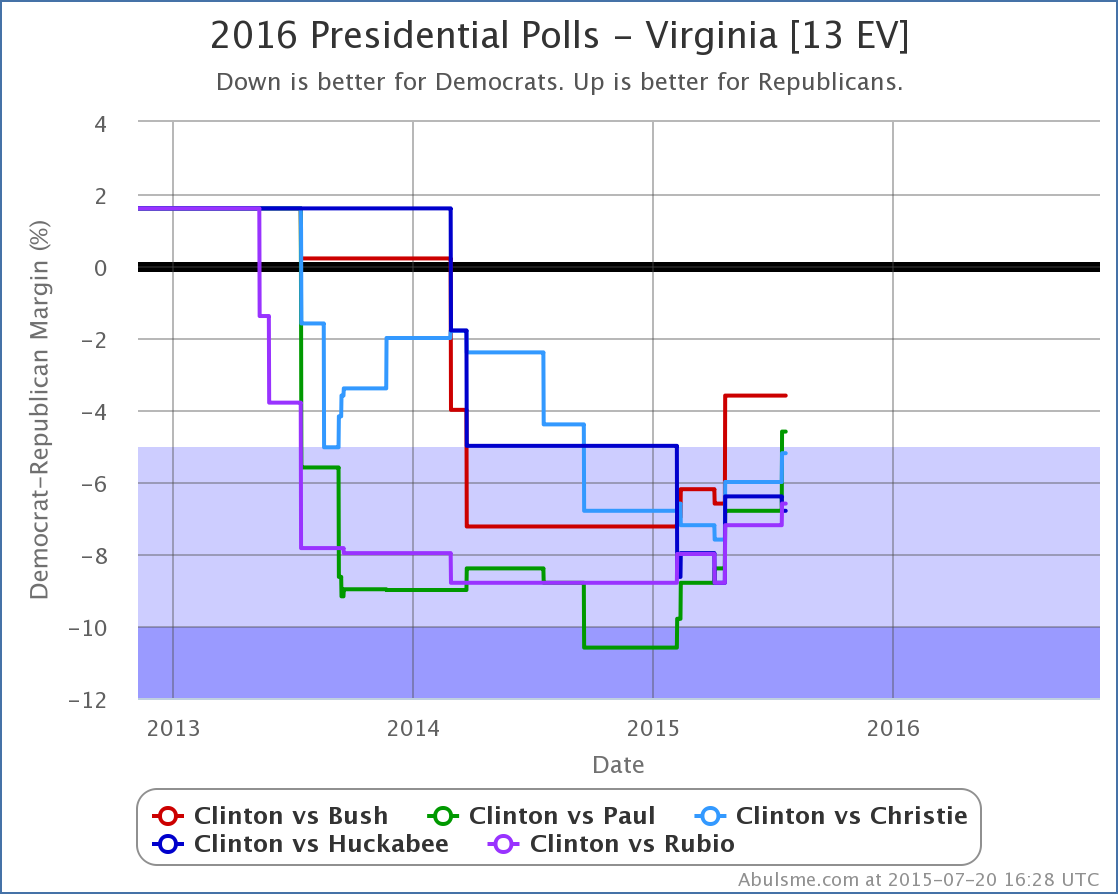
Looking back six months… Bush, Paul, Christie and Rubio have all improved vs Clinton. Only Huckabee has declined in that time frame.
Then the “best cases”:
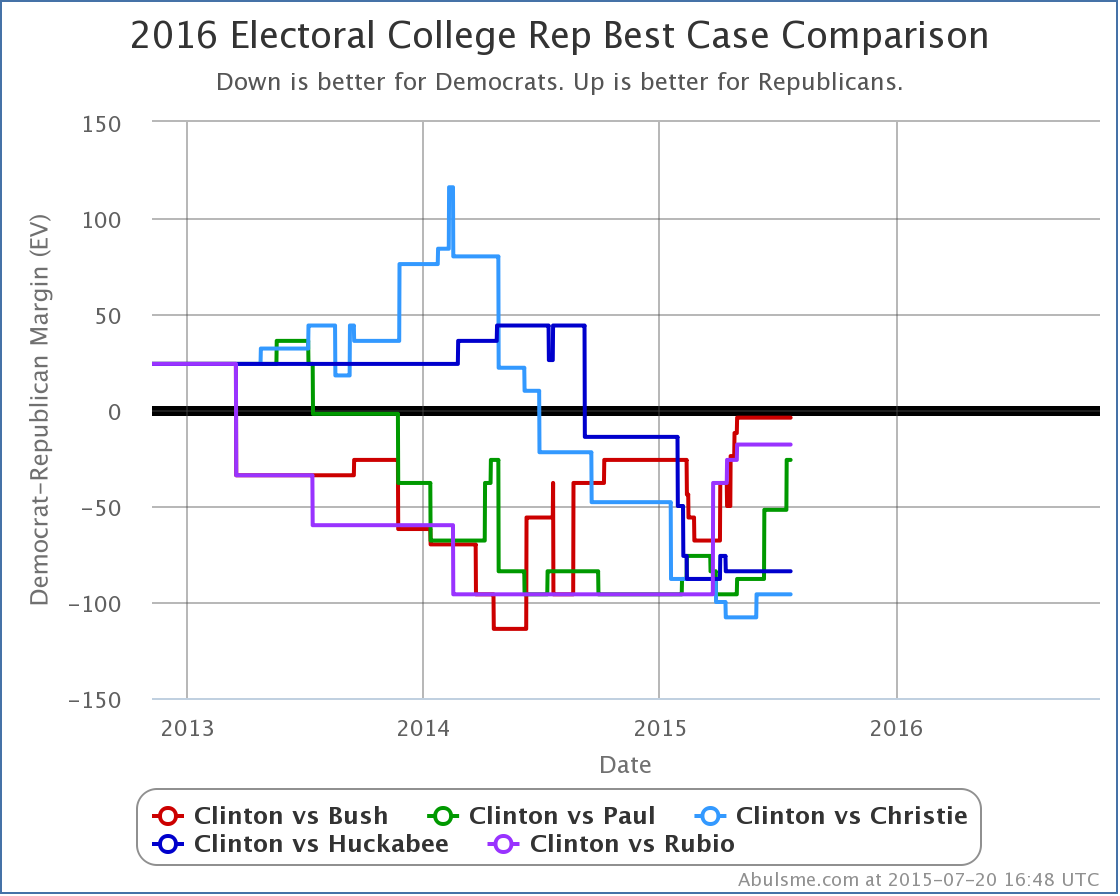
Again looking back six months, this time Bush, Paul and Rubio have all improved, while Christie and Huckabee have declined.
Finally, the tipping points:
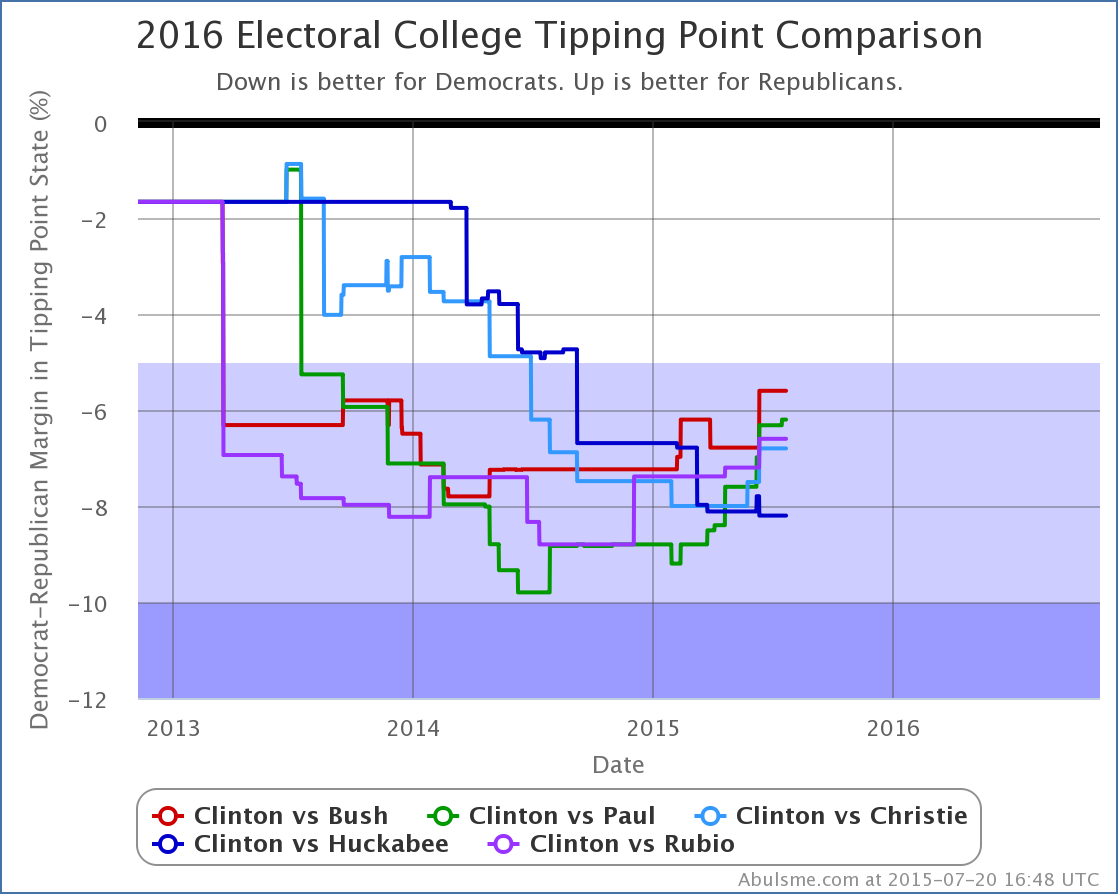
Once again, everybody is gaining on Clinton… except Huckabee. Poor Huckabee.
Anyway, together this means that Clinton seems to be weakening generally against most of the Republican candidates, this isn’t something special for Paul. Today’s update just happened to have him be the one to flip categories today.
Having said that though, if you look at the amount Paul has moved in the three graphs above vs the other four competitors, he’s had the biggest move in Virginia, the biggest move in tipping point, and the second largest move in “best case”. So perhaps there is actually something going on with Paul separate from the more general move against Clinton.
For any of that to matter though, he would still have to win the nomination, which is a long shot. But still…
477.3 days until polls start closing.
Note: This post is an update based on the data on my 2016 Electoral College Analysis Site. All of the charts and graphs seen here are from that site. Graphs, charts and raw data can be found there for the race nationally and in each state for every candidate combination that has been polled at the state level. In addition, comparisons of the best polled candidate combinations both nationally and each in each state are available. All charts above are clickable to go to the current version of the detail page the chart is from, which may contain more up to date information than the snapshots on this page, which were current as of the time of this post. Follow @ElecCollPolls on Twitter for specific poll details as I add them.
Only one change of note this week. PPP did another poll of North Carolina. Of the five best polled candiate pairs… right now still Clinton vs Bush, Paul, Christie, Huckabee, and Rubio… only Clinton vs Huckabee resulted in a category change.
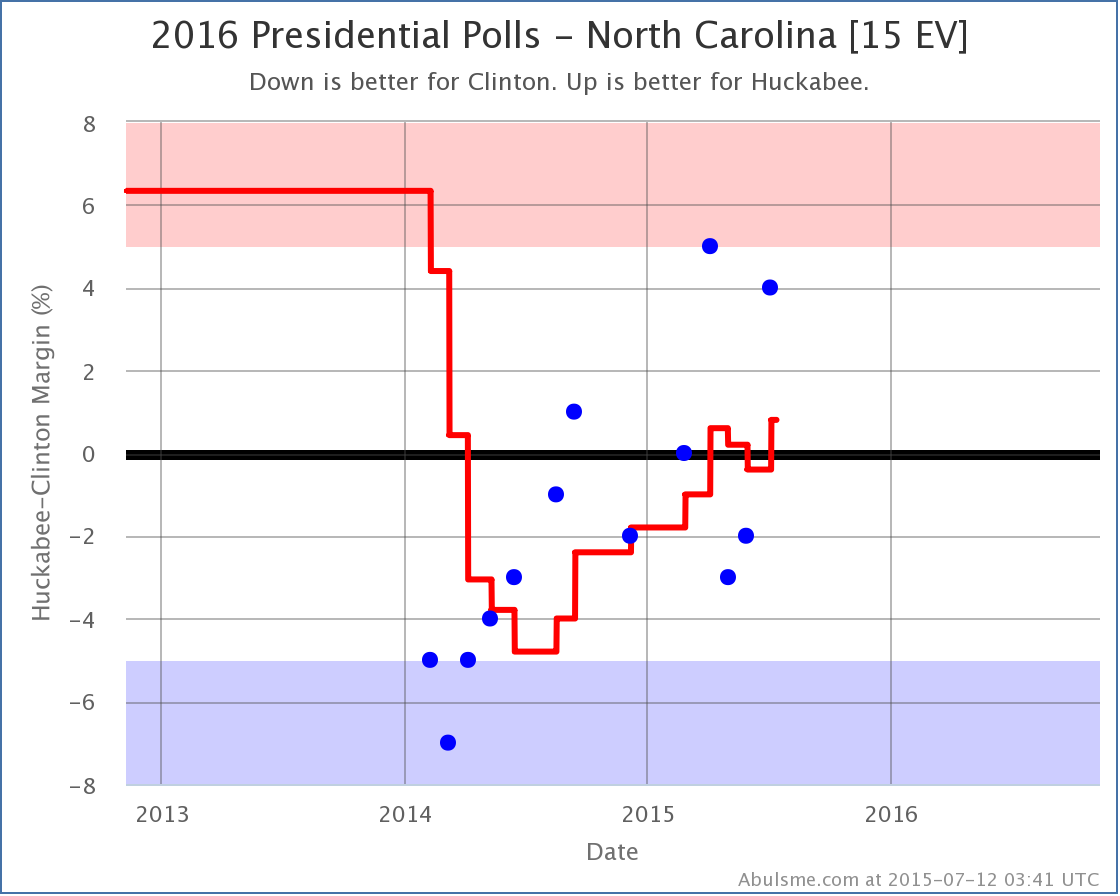
Huckabee takes the lead again after having lost it at the end of May. Looking at the long term trend, Huckabee has been gaining against Clinton in North Carolina for the last year or so. Now, is this just Huckabee, or part of a larger trend against Clinton?
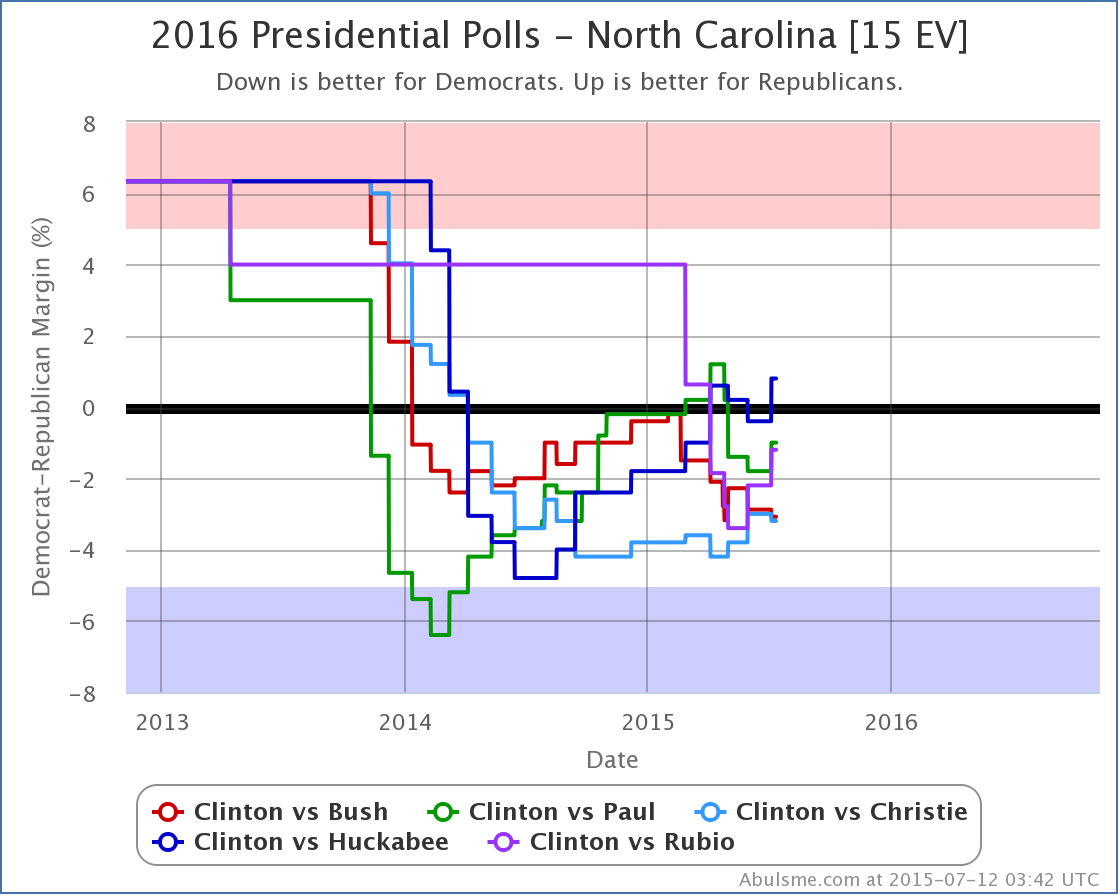
Lets look at how each of these five candidates has done against Clinton in North Carolina over the last six months, namely comparing where they stand today (July 12) vs where they were six months ago (January 12).
- Clinton vs Huckabee: Clinton by 1.8% -> Huckabee by 0.8% (2.6% Huckabee gain)
- Clinton vs Christie: Clinton by 3.8% -> Clinton by 3.2% (0.6% Christie gain)
- Clinton vs Paul: Clinton by 0.2% -> Clinton by 1.0% (0.8% Clinton gain)
- Clinton vs Bush: Clinton by 0.4% -> Clinton by 3.1% (2.7% Clinton gain)
- Clinton vs Rubio: Rubio by 4.0% -> Clinton by 1.2% (5.2% Clinton gain)
So, no. There hasn’t been an across the board Republican gain here, at least not over the last six months. (There is a bit more of move toward the Republicans if you look back a whole year.) Over six months though, we have Huckabee and Christie doing better against Clinton, while Paul and Bush are doing worse.
(You can discount the Rubio results, as six months ago there was only one actual Clinton vs Rubio poll in NC, so this was primarily movement toward the real Rubio numbers away from the average of previous election results, rather than actual movement in Clinton vs Rubio.)
Given this, there might really be something to the notion that Huckabee may be getting some resonance in North Carolina that Bush is not.
Regardless though, North Carolina is “close” for all five of these candidates against Clinton. It could very easily go either way. The differences between these five candidate pairs aren’t actually all that huge. North Carolina is looking like it will definitely be one of the swing states this cycle.
Looking back at Huckabee for a minute, we can see how this changes his “expected” result vs Clinton:
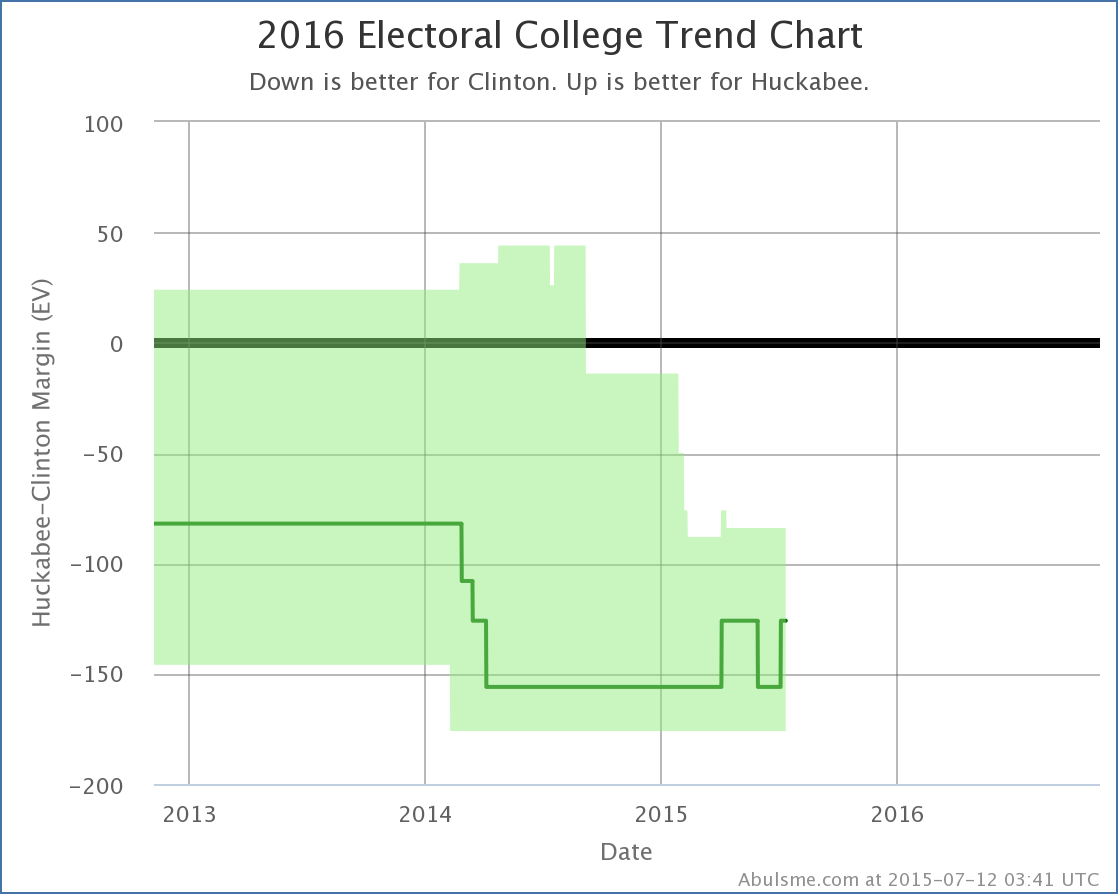
With North Carolina back in his column, if each candidate won every state they are currently ahead in, we end up with… Clinton 332 to Huckabee 206. This is a 126 electoral vote win for Clinton.
This is also an exact match for the 2012 election results, which were Obama 332 to Romney 206. Not only do the numbers match, but every single state matches. So with today’s polls, with Clinton and Huckabee, we essentially end up with an exact rerun of 2012.
Interestingly though, if you look at just the “expected” results such as the above, and not the “best cases” for each of the Republicans (where you give them all the states where Clinton is ahead by less than 5% too) then at the moment, somewhat shockingly I think… Huckabee is actually out performing each of the other four Republicans in the five best polled candidate combinations:
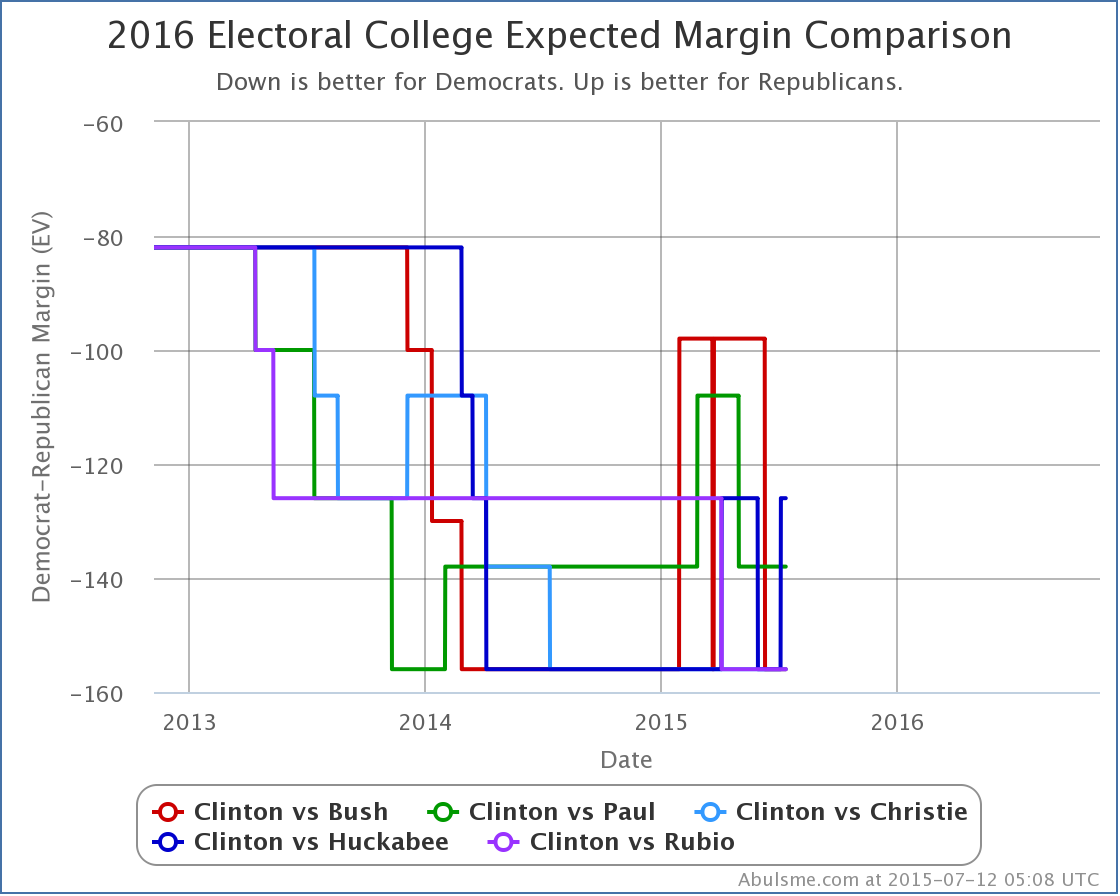
Of the five best polled candidates:
- Clinton vs Huckabee: Huckabee loses by 126 – exact match of 2012
- Clinton vs Paul: Paul loses by 138 – Paul gets all Romney states except NC (15 ev), but gains CO (9 ev)
- Clinton vs Bush, Christie and Rubio: Republican loses by 156 – Republican gets all Romney states except NC (15 ev)
So, with all the polling and back and forth so far and all my various squiggly lines… at least as of today… the only states that are shifted from 2012 for any of these five candidates against Clinton are Colorado and North Carolina. Barely any change at all!
But, as I always try to make sure to mention: All of these numbers are “if the election was held today” numbers, and the election is most certainly not held today! (And there are still many states with little or no 2016 polling yet.)
There will be a lot of events between now and the election, and a lot of campaigning, and a lot more polling. Plenty of time for things to change… potentially a lot.
485.8 days until the first polls close as I post this. Stay tuned!
Note: This post is an update based on the data on my 2016 Electoral College Analysis Site. All of the charts and graphs seen here are from that site. Graphs, charts and raw data can be found there for the race nationally and in each state for every candidate combination that has been polled at the state level. In addition, comparisons of the best polled candidate combinations both nationally and each in each state are available. All charts above are clickable to go to the current version of the detail page the chart is from, which may contain more up to date information than the snapshots on this page, which were current as of the time of this post. Follow @ElecCollPolls on Twitter for specific poll details as I add them.
Today’s update (which included a Detroit News poll in MI and Quinnipiac polls in Florida, Ohio and Pennsylvania) brings seven changes of note to the five best polled candidate pairs. Plus Clinton vs Bush once again takes the top spot as the best polled candidate pair, but there isn’t much else to say about that. As usual, click on any of the charts for more details from election2016.abulsme.com or follow @ElecCollPolls on Twitter for detailed poll information as I add it.
Tipping Point Moves
Five of those seven changes are tipping point changes. (Reminder: The tipping point is the margin in the state that would put the winning candidate “over the top” in the electoral college.) The tipping point changed for all five of the candidate pairs, so instead of looking at them individually, lets look at the comparison:
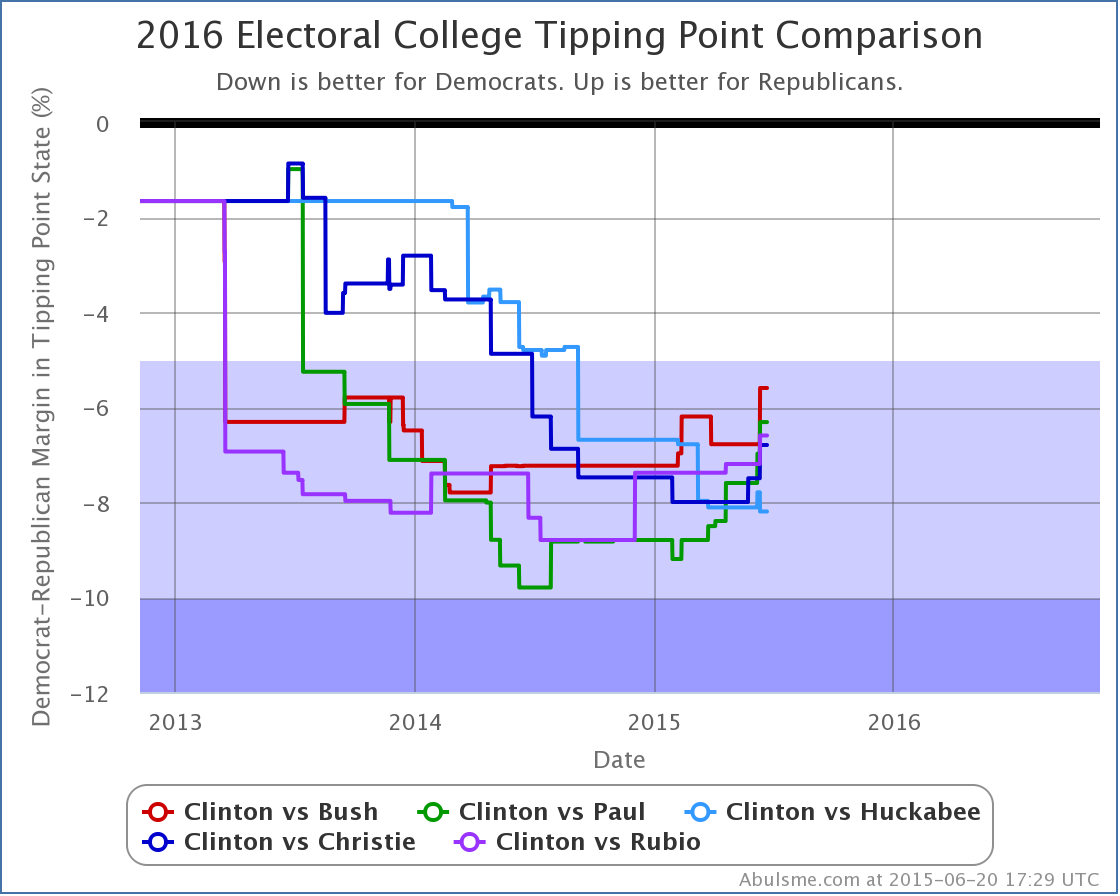
Looking both at the most recent change, and also at the change over the last three months, Bush, Paul, Christie and Rubio have all improved vs Clinton. Only Huckabee’s situation has worsened. For the candidates that are improving, the movement seems to be accelerating.
Bush’s tipping point specifically is down to only 5.6%. This still translates into a “Strong” lead for Clinton according to the categories I have defined, but we’re getting pretty close to the 5.0% boundary. Just a few more good polls for Bush in the right states, and the tipping point could move into the “Weak Clinton” zone, meaning that if Bush managed to win all of the close states (including the ones where Clinton is a little ahead) he would win. At that point, we would have an actual competitive race. Clinton would still be ahead, but a Bush win would be within the realm of reasonable possibility.
Clinton vs Bush
In addition to the tipping point changes, a couple of states changed categories. First up, Bush in Florida.
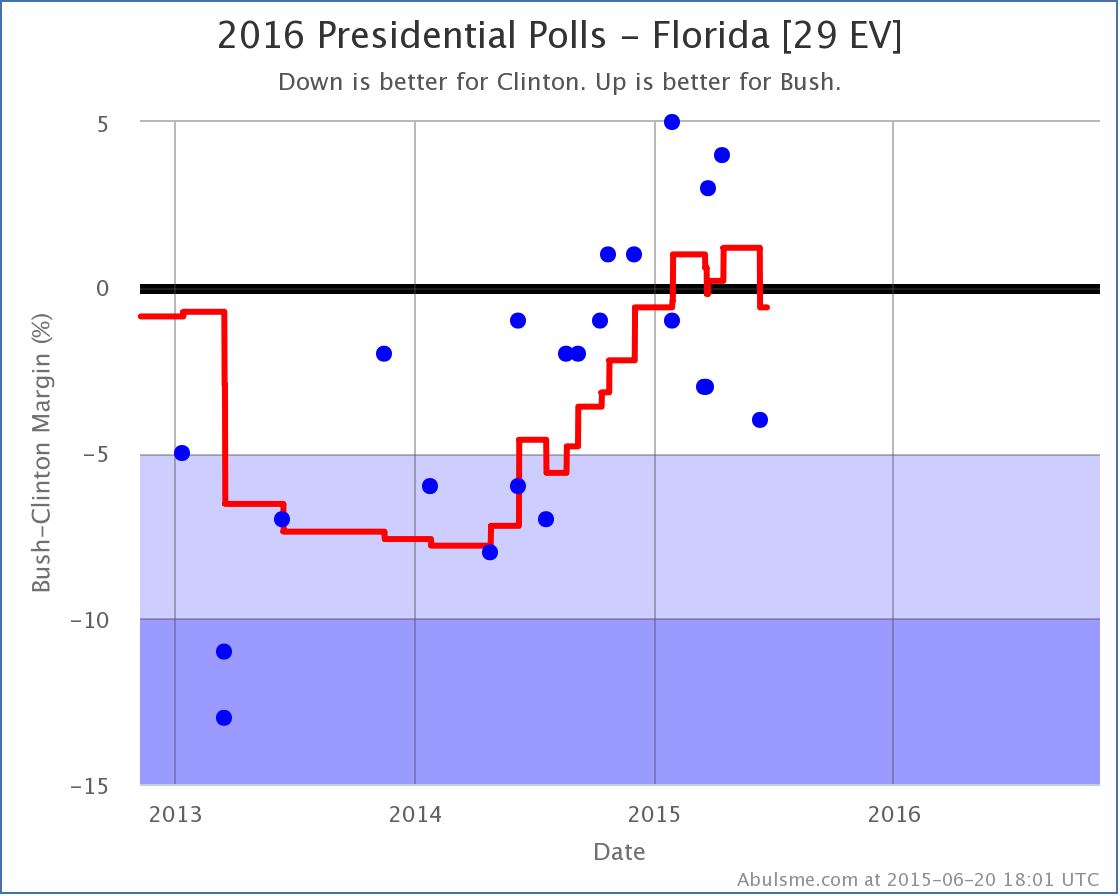
Florida moves from just barely Bush, to just barely Clinton. Bottom line, in this paring, Florida is close. Right now this is true for only Bush and Rubio. The other three Republican candidates in the top five polled pairs trail Clinton badly:
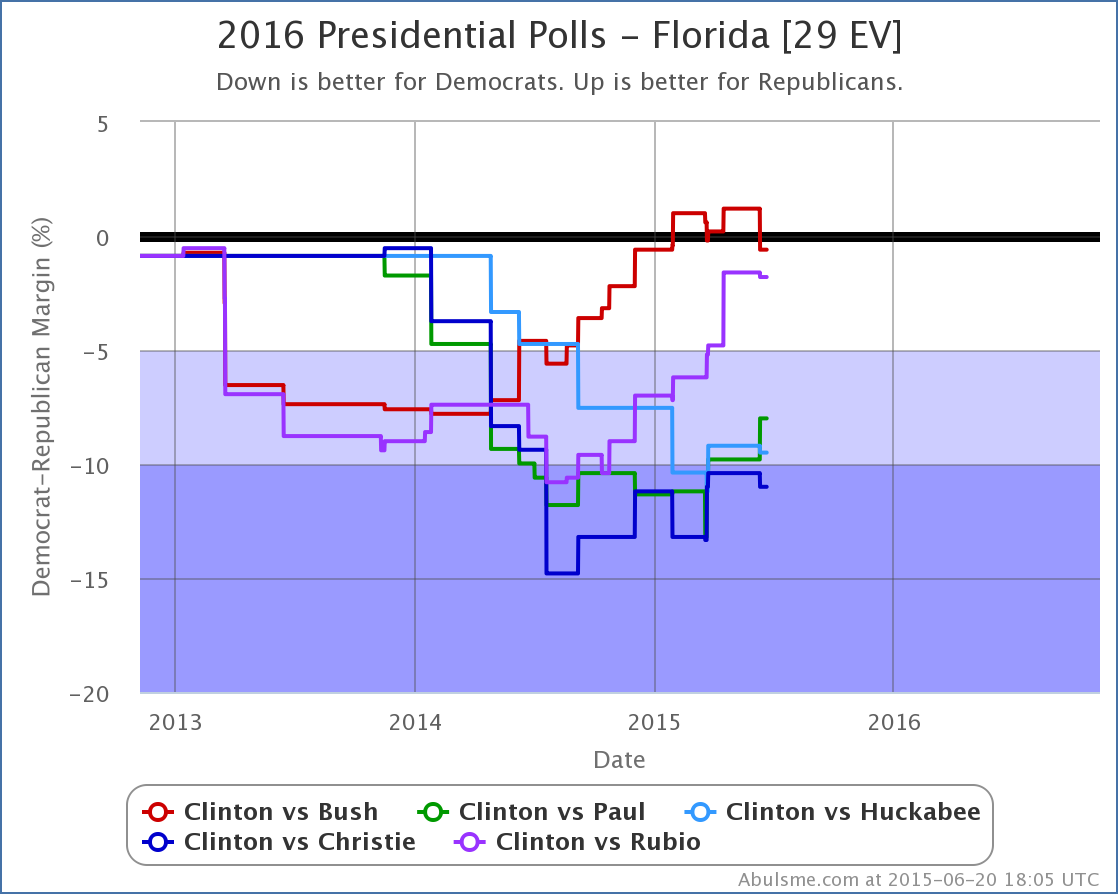
For Bush though, for the moment, Florida slips off the list of states he is ahead in, and his “expected case” drops:
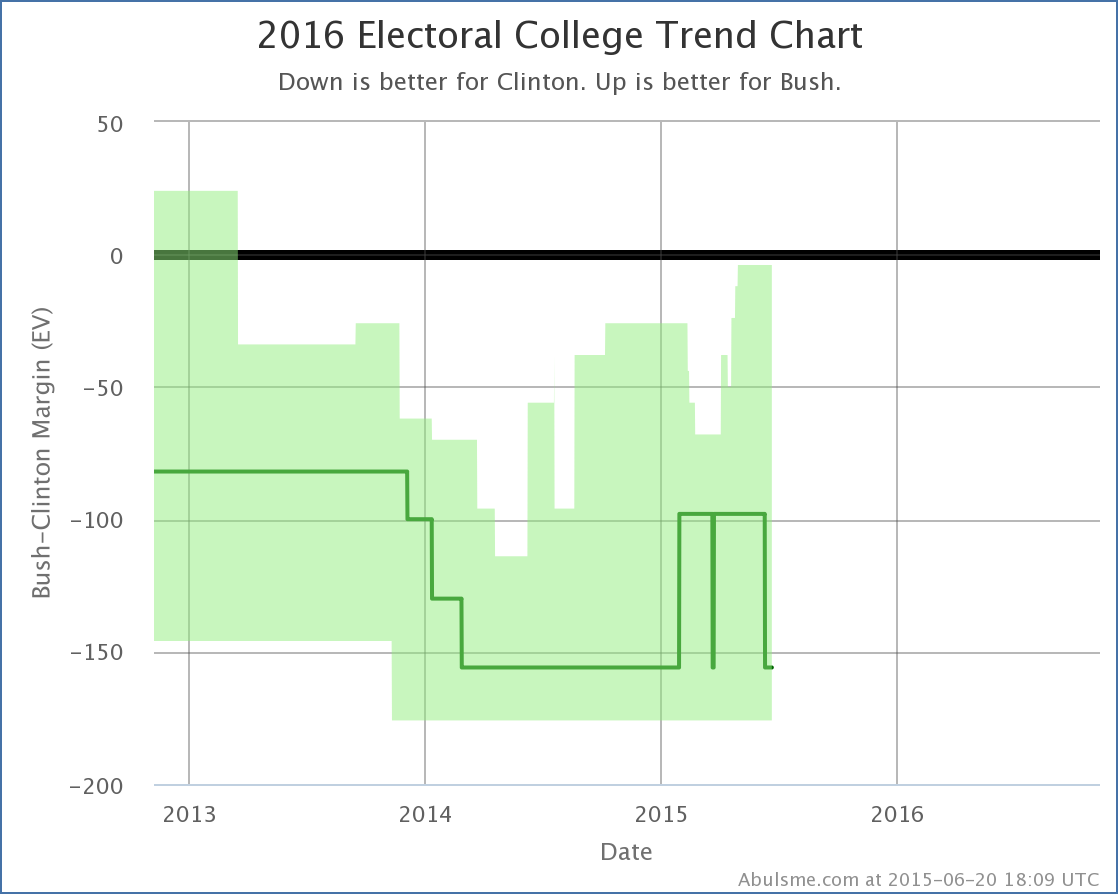
This brings Bush’s “expected” result back to Clinton 347 to Bush 191, a 156 electoral vote loss. (This is the same margin at the moment as Huckabee, Christie and Rubio… only Paul differs right now, losing by only 138 electoral votes because unlike the others, Paul is ahead in Colorado.)
Clinton vs Paul
The other category change is that in Clinton vs Paul, Ohio moves from Strong Clinton to Weak Clinton:
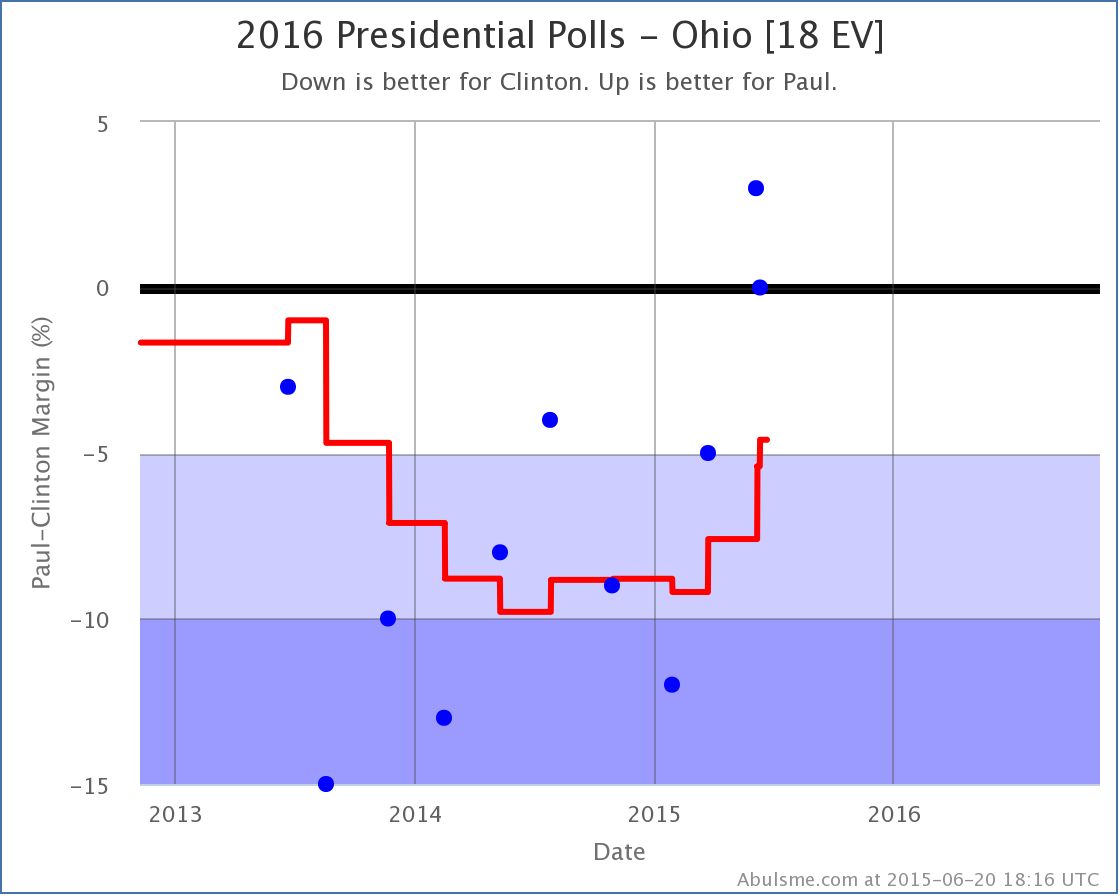
The last two polls actually show Paul ahead in Ohio. The average, which covers almost 8 months of polls at the moment, isn’t there yet, but it is moving in Paul’s direction. Ohio is looking closer and closer.
And that isn’t just Paul. If we do the comparison in Ohio, we see this movement is broader:
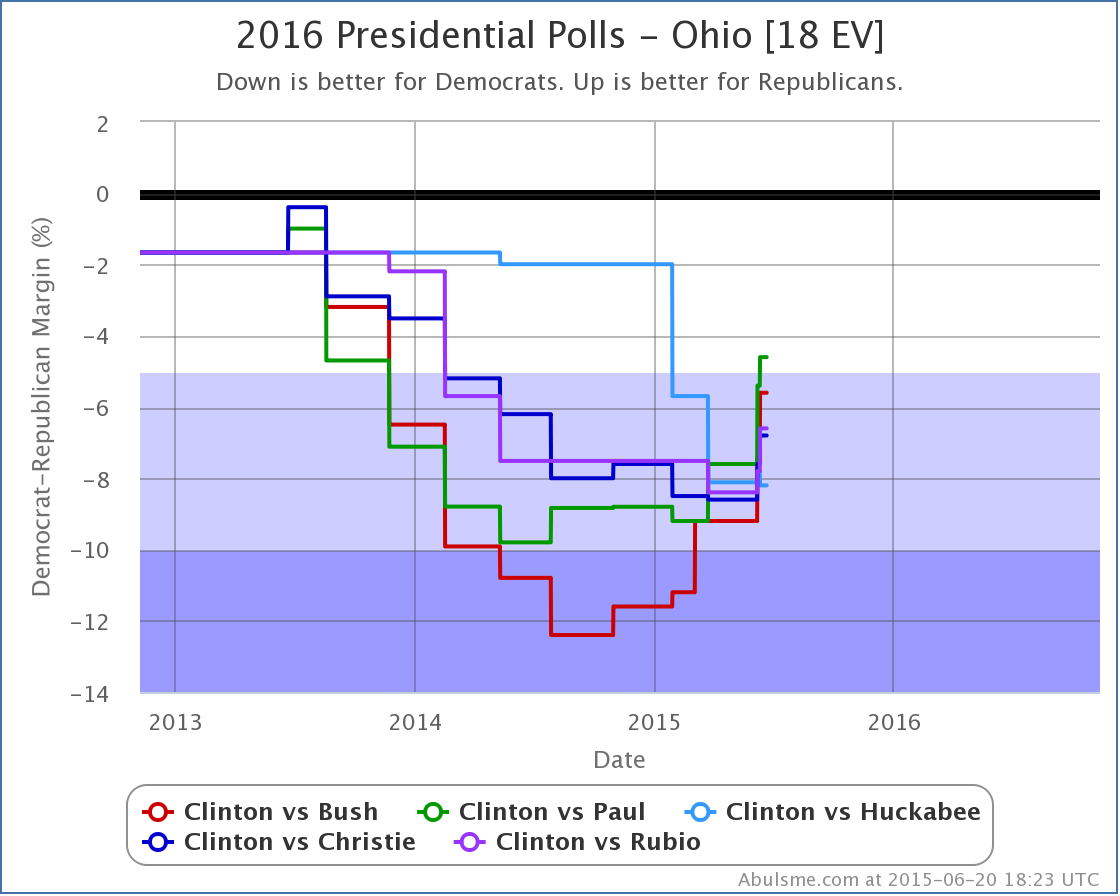
Once again, everybody except Huckabee is improving against Clinton. Or perhaps it would be better to say that Clinton is falling. Either way, Ohio is looking closer than it did. Paul is the first of these five candidates to move Ohio into the “potential win” category according to my classifications, but Bush isn’t far behind.
For Paul, this improves his “best case” where we give him all of the states he is ahead in, plus all the states where Clinton’s lead is less than 5%:
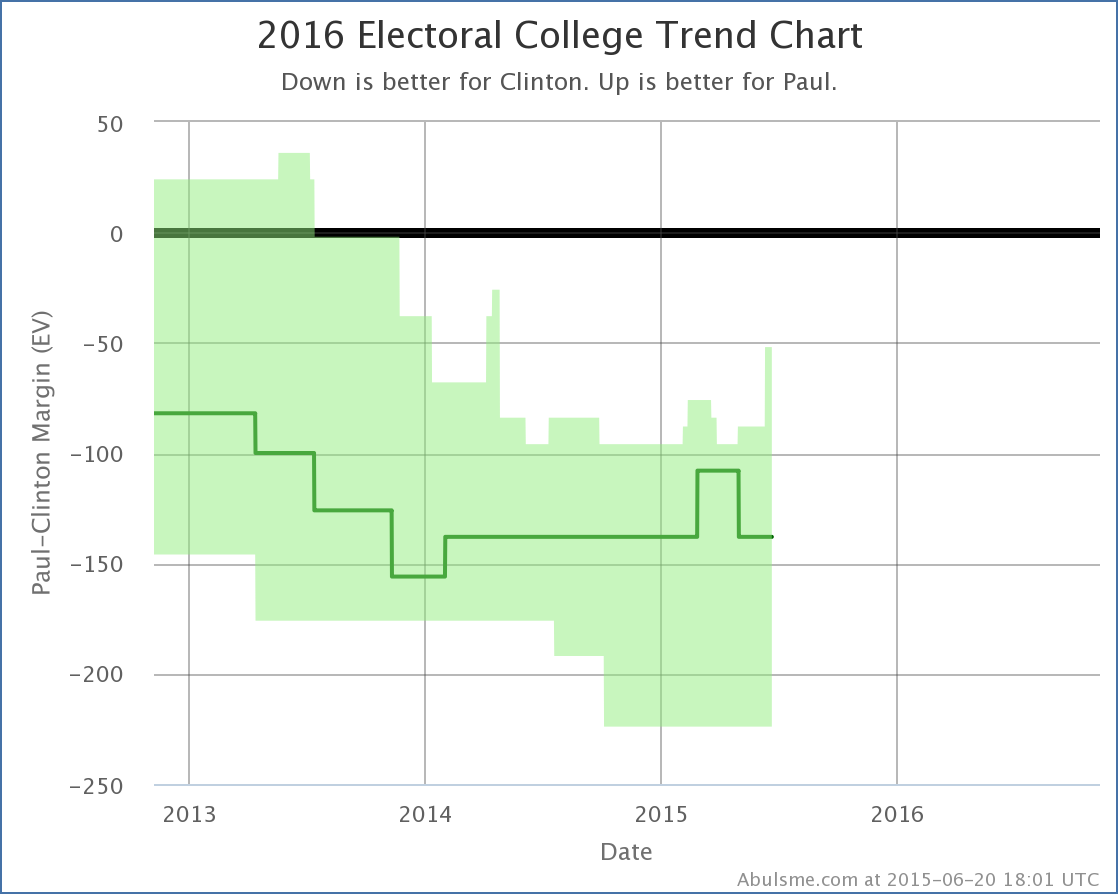
In his “best case” Paul now only loses to Clinton by 52 electoral votes. This is Paul’s best best case since I officially launched this analysis after the November election.
Pennsylvania
The polls this time around in Michigan didn’t change anything, but the ones in Pennsylvania are worth mentioning even though there were no category changes for any of the five candidate pairs.
Brandon Finnigan (@ConArtCritic) of the Ace of Spades HQ Decision Desk election tracking site tweets constantly about how Republicans should be targeting Pennsylvania as the keystone (get it?) to their election strategy. In his recent article “How The GOP Could Win Pennsylvania” he outlines the argument. So lets look at how the state is going given current polling. (Which of course will change a lot before we get to the election.)
Moves in Pennsylvania did contribute to some of the tipping point changes we talked about today, and when we look at Pennsylvania, we are seeing what looks like clear movement toward the Republicans, even though it isn’t quite switching categories yet:
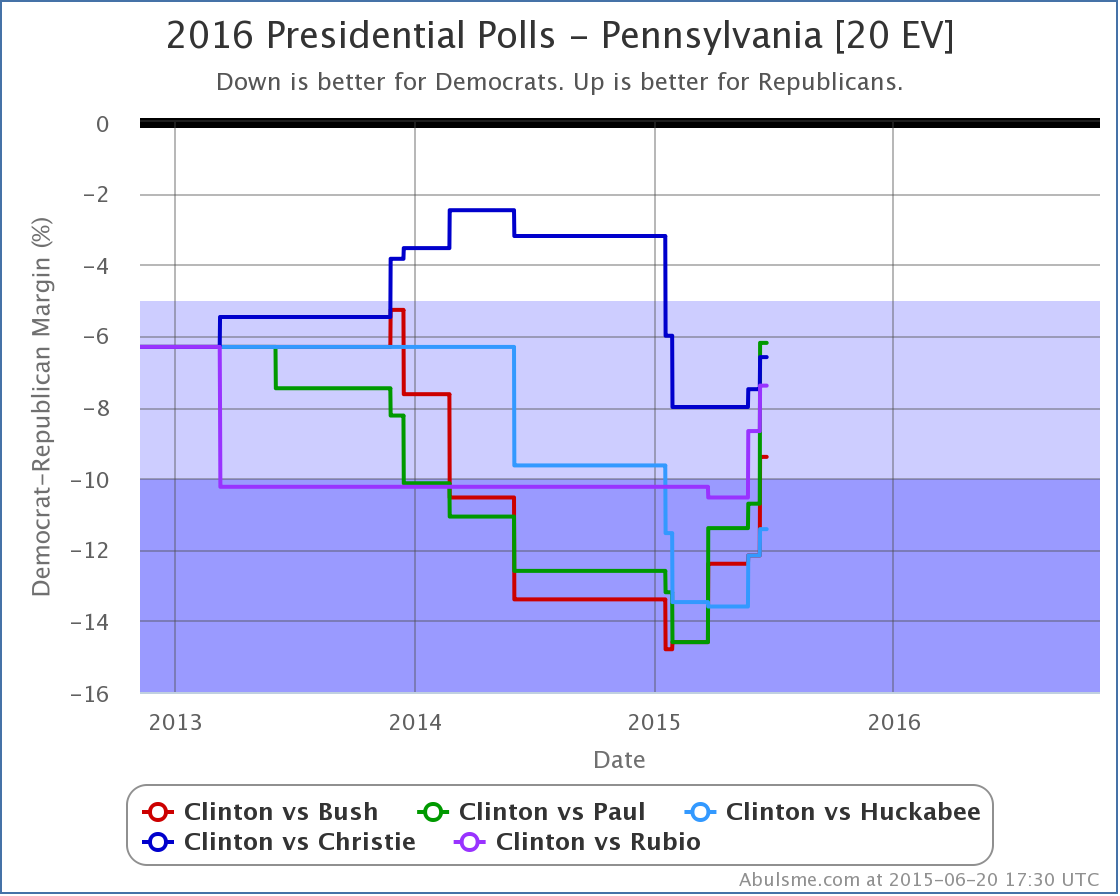
All five candidates have improved against Clinton in the last three months, some of them by large margins. Paul went from down by 14.6% in March, to down by only 6.2% right now. That is a huge move!
Now, this probably isn’t because any of the candidates are specifically targeting Pennsylvania at this point, but more likely just a reflection of Clinton’s overall decline nationally. None of the candidates have made it close in my poll averages yet, but Clinton’s margins have been narrowing rapidly.
Finnigan is certainly right that if the Republicans can make Pennsylvania close, let alone turn it red, this probably means an overall Republican victory in the electoral college, because whatever they did that could flip Pennsylvania would almost certainly flip other blue states that currently are closer than Pennsylvania as well.
Now, does that mean targeting Pennsylvania specifically rather than going after those closer states first is the best strategy? I don’t know.
For Bush for instance, if you start with the states he is already ahead in and then see which states he would need to flip to win, you get this list (in order by how far behind Bush is right now in my poll averages):
At that point Bush would have enough electoral votes to win. To get to Pennsylvania on this list, you’d have to also go past Minnesota, Nevada, Wisconsin, and Michigan. Then Pennsylvania.
Would it be better to concentrate directly on the seven states above? Or is jumping forward to Pennsylvania’s 20 electoral votes somehow an easier path? If Pennsylvania is specifically more vulnerable due to some of the factors Finnigan mentions, then maybe.
I think Finnigan’s point is broader than that though. It isn’t that Pennsylvania is a better target than Ohio or Colorado, although maybe it is. It is more that if the Republicans took Pennsylvania seriously, and did everything they needed to do to win Pennsylvania, then those same things could be applied more broadly, and a lot of other states would move too, and the Republicans would not just win, but win clearly, not a “just barely” sort of win like they got in 2000 and 2004.
The movement we’re seeing so far does show that Pennsylvania is movable. Can it move enough to make it red? I have my doubts absent the Democratic candidate simply collapsing on a nationwide basis. But Pennsylvania might be worth watching anyway…
Bottom Line
Aside from Florida moving her direction but remaining pretty close, and Huckabee generally not doing well, Clinton seems to be continuing to weaken against most Republicans. This reflects the campaign beginning to get under way in earnest, and the name recognition gap slowly diminishing. The question is where this trend ends. After a few debates happen, do we reach some sort of steady state Clinton lead a bit narrower than it is today, or do the Republicans continue to gain on her until we really have a race that could go either way, or even with Republicans in the lead?
As usual, stay tuned. 507 days to go!
Note: This post is an update based on the data on my 2016 Electoral College Analysis Site. All of the charts and graphs seen here are from that site. Graphs, charts and raw data can be found there for the race nationally and in each state for every candidate combination that has been polled at the state level. In addition, comparisons of the best polled candidate combinations both nationally and each in each state are available. All charts above are clickable to go to the current version of the detail page the chart is from, which may contain more up to date information than the snapshots on this page, which were current as of the time of this post. Follow @ElecCollPolls on Twitter for specific poll details as I add them.
Edit 23:07 UTC to add some additional links to the election site and Twitter.
This last week brought a new set of Ohio results from PPP. With this poll Clinton lost significant ground against basically all opponents in the averages. Concentrating as we usually do on the five best polled candidate combinations, this is what we see:

All five of these candidates improved against Clinton based on this latest poll. Looking back a little and comparing now with three months ago, we see that Paul, Bush and Christie have improved their positions, while Rubio and Huckabee have fallen further behind. Of these, Paul has moved the most, from down by 9.2% in March, to only down by 5.4% now, a gain of 3.8%. Paul now does the best of these five candidates against Clinton in Ohio.
Ohio is not a good place for Clinton to be losing ground. Ohio’s 18 electoral votes can make a huge difference. Many paths for Republican victory require Ohio. And the losses here are quite possibly indicative of similar slippage in other states that haven’t been polled enough lately to see it yet. This is not a happy trend for Team Clinton.
Lets switch to looking nationally. Do we see loss of ground there too?
These changes in the Ohio average directly change the tipping point for two of the five candidates, Paul and Huckabee. Paul moves from being down by 7.6% with the tipping point in Ohio, to only being down 7.0% in Minnesota. Meanwhile Huckabee moves from being down 8.1% with the tipping point in Ohio, to being down 7.8%, with his tipping point still in Ohio.
But lets look again at all five candidates against Clinton over not just this change, but the last few months:

Once again lets compare now to three months ago. Remember, the tipping point essentially represents how much national public opinion needs to move to flip the electoral college result. Paul, Huckabee, Christie and Rubio have all improved since March. Only Bush has declined in that timeframe. (Bush is still better than he was six months ago though.)
Also once again, Paul has improved the most against Clinton during that the last three months, going from down 8.8%, to only down 7.0%.
And yes, yes, all five of these candidates are still way behind. But the overall movement seems to be in the Republican’s favor at the moment. If these trends continue, before too long we may have an actual race on our hands instead of a Clinton blowout!
As I noted in the latest Curmudgeon’s Corner podcast, the real media bias is toward having an exciting race, and while I’m not “the media” I am not immune to this bias… a closer race is a more fun race to watch… so I’ll always be rooting for whoever is behind. :-)
Seriously though, when I posted my first analysis of the 2016 race on this site in November, I mentioned that we should expect tightening, and that Clinton would most likely never again look as good as she did then. The general public had barely heard of most of the non-Clinton candidates, she had come off her Secretary of State stint with fairly high approval ratings, and the campaign against her had yet to start in earnest… and she had been keeping quiet, so fewer opportunities for her to make mistakes too.
As things get in to gear, all of those things change. We’ve just seen the very beginnings of this, and already there is a visible impact in Clinton’s lead. Her lead is still a healthy one, but we’re definitely seeing the signs of the battle starting to be engaged.
513 days to go.
Note: This post is an update based on the data on my 2016 Electoral College Analysis Site. All of the charts and graphs seen here are from that site. Graphs, charts and raw data can be found there for the race nationally and in each state for every candidate combination that has been polled at the state level. In addition, comparisons of the best polled candidate combinations both nationally and each in each state are available. All charts above are clickable to go to the current version of the detail page the chart is from, which may contain more up to date information than the snapshots on this page, which were current as of the time of this post.
With today’s batch of polls added, Clinton vs Paul goes back to being the “best polled” candidate combination by my metric and thus is again the default view on election2016.abulsme.com. No status changes on Clinton vs Paul though.
There were however two other status changes of note that I’ll highlight here. (There were status changes below the five best polled candidate combinations as well, see @ElecCollPolls for those, or for details of the specific polls added today.)
Clinton vs Huckabee

After a flirtation in April and May with actually leading Clinton in North Carolina, the state moves from just barely Huckabee, to just barely Clinton. Either way, North Carolina looks close in this matchup for the moment. This does however change the “expected” result in this match up in Clinton’s favor:
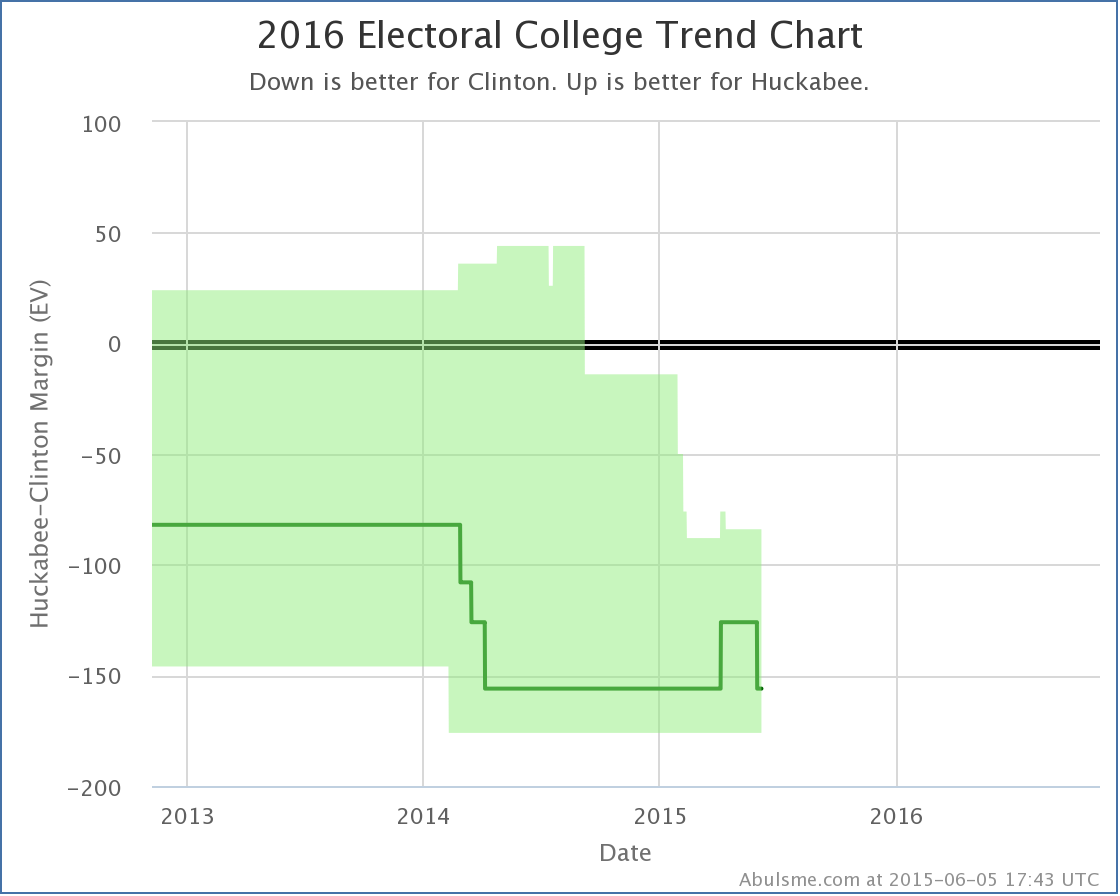
With this, the expected result… where each candidate wins all the states where they are currently ahead… returns to Huckabee losing by 156 electoral votes. (Specifically Clinton 347, Huckabee 191.) This has been the “expected” Clinton vs Huckabee result for most of the last year.
Clinton vs Christie

With the latest poll, the poll average for Clinton vs Christie in Iowa show’s Clinton’s lead below 5% for the first time since almost exactly a year ago. A 4.8% lead is still nothing to sneeze at, but it is close enough that we now allow for the possibility of Christie winning Iowa in our range of reasonably possible outcomes, so Christie’s “best case” improves:

That bump in the top right of the green envelope is the improvement we’re talking about here. Christie’s best case is still a 96 electoral college loss to Clinton. Along with his tipping point improvement that I noted on Saturday though, this makes two moves in Christie’s direction in a week, so maybe there is some new momentum in his direction? Nah, probably not, right?
The Others
There may or may not be a specific move toward Christie, but lets look at the comparison chart in Iowa for all five of the “best polled” candidate combinations…

Hmm, definitely looks like some movement there in the last couple months.
Clinton’s lead seems to be evaporating in Iowa vs all five of these Republican challengers. But isn’t she spending all sorts of time in Iowa right now? Of course, Iowa gets attention due to the caucus of course, not an much for the general election, but still. This isn’t a good trend for Clinton.
There is no clear move like this on any of my national trend lines yet, but those take some time to move given that you need polling from a lot of states. But Iowa is one of the most polled states, so this could be a warning sign for Clinton’s broader situation.
522 days until the polls start closing. Plenty of time for drama and movement. Stay tuned!
Note: This post is an update based on the data on my 2016 Electoral College Analysis Site. All of the charts and graphs seen here are from that site. Graphs, charts and raw data can be found there for the race nationally and in each state for every candidate combination that has been polled at the state level. In addition, comparisons of the best polled candidate combinations both nationally and each in each state are available. All charts above are clickable to go to the current version of the detail page the chart is from, which may contain more up to date information than the snapshots on this page, which were current as of the time of this post.
|
|



















































